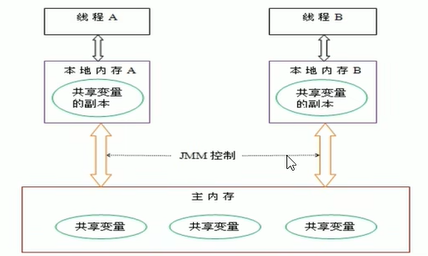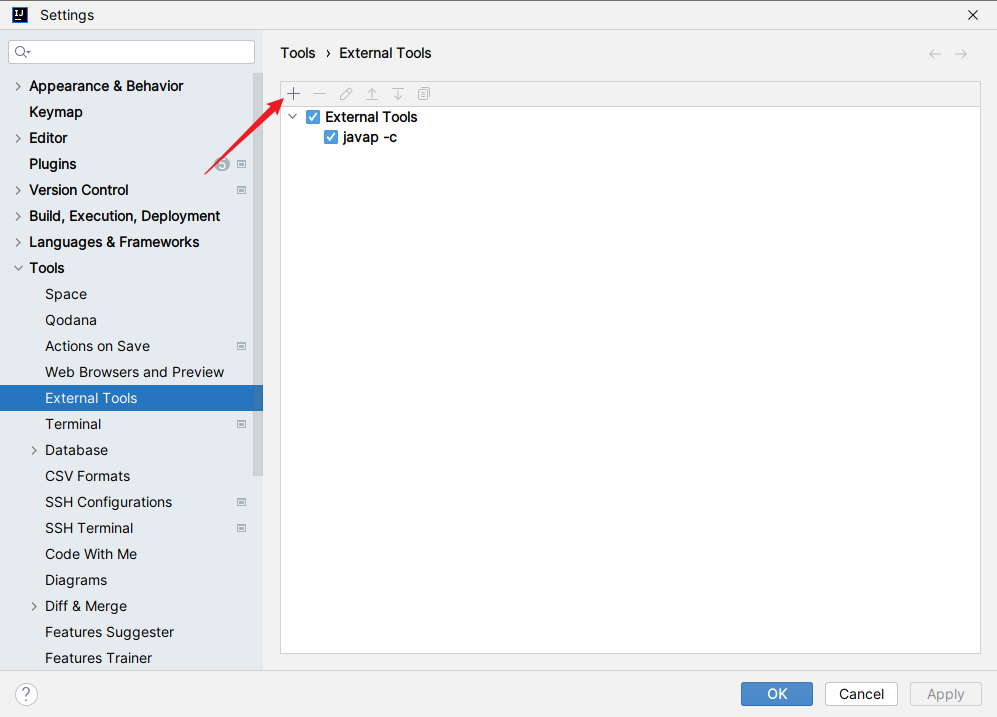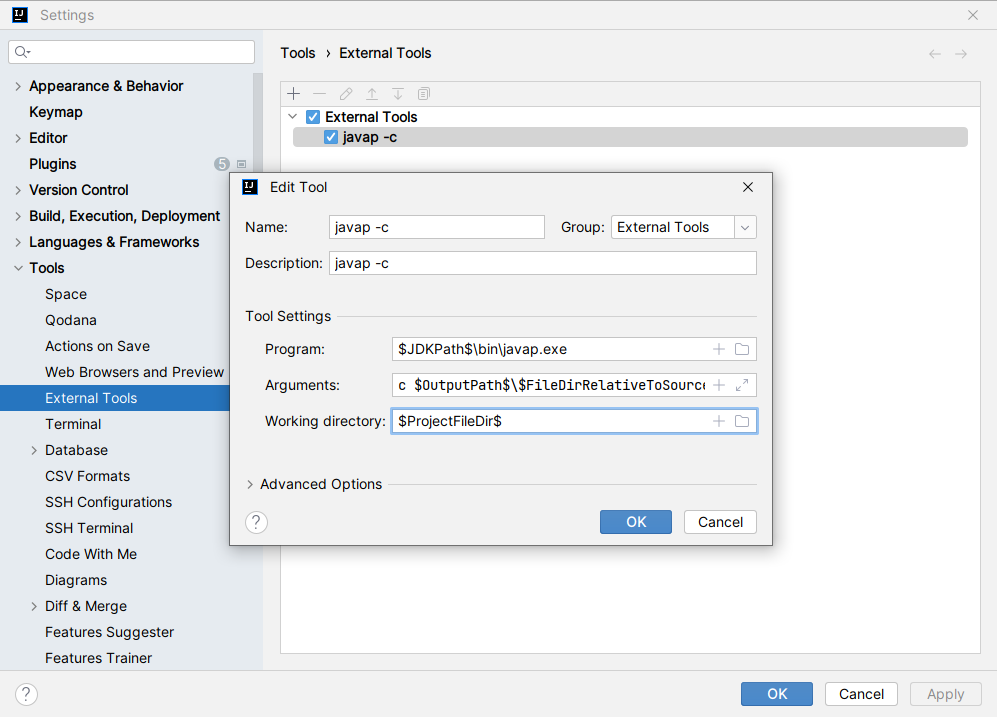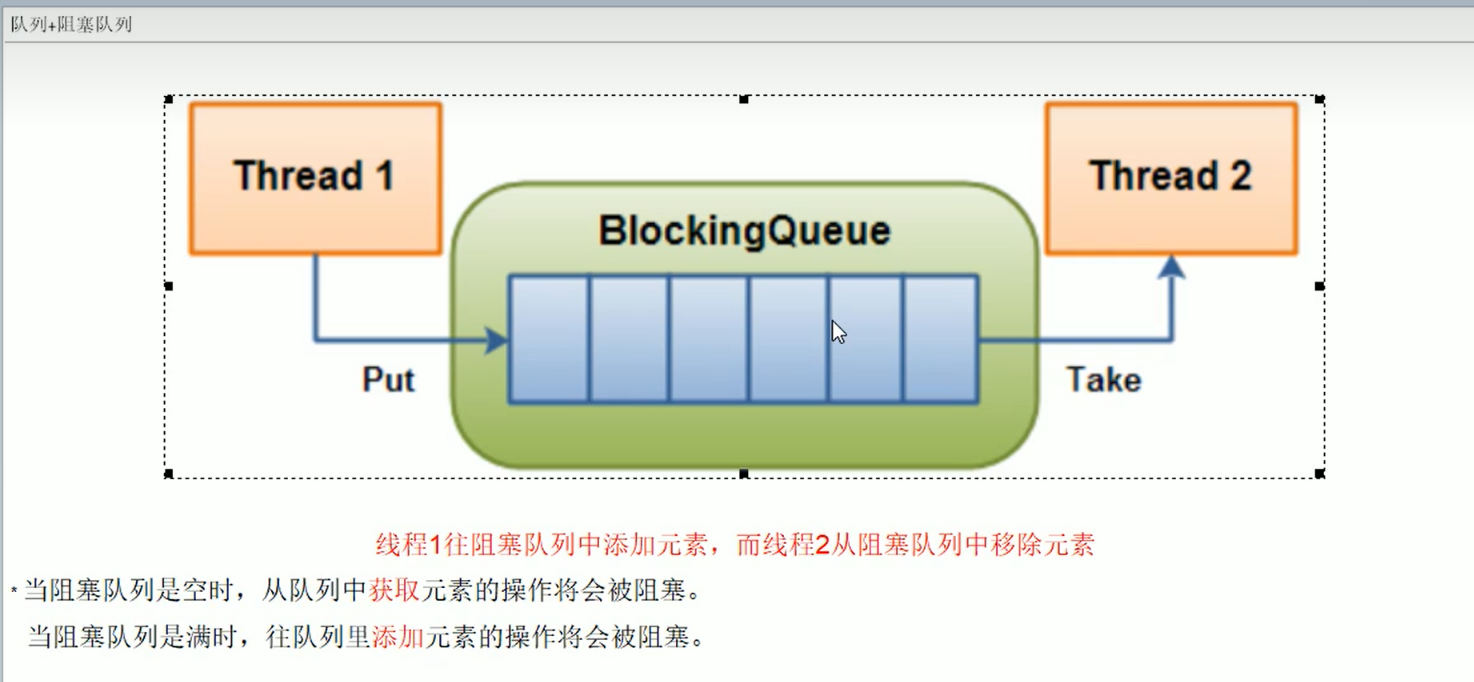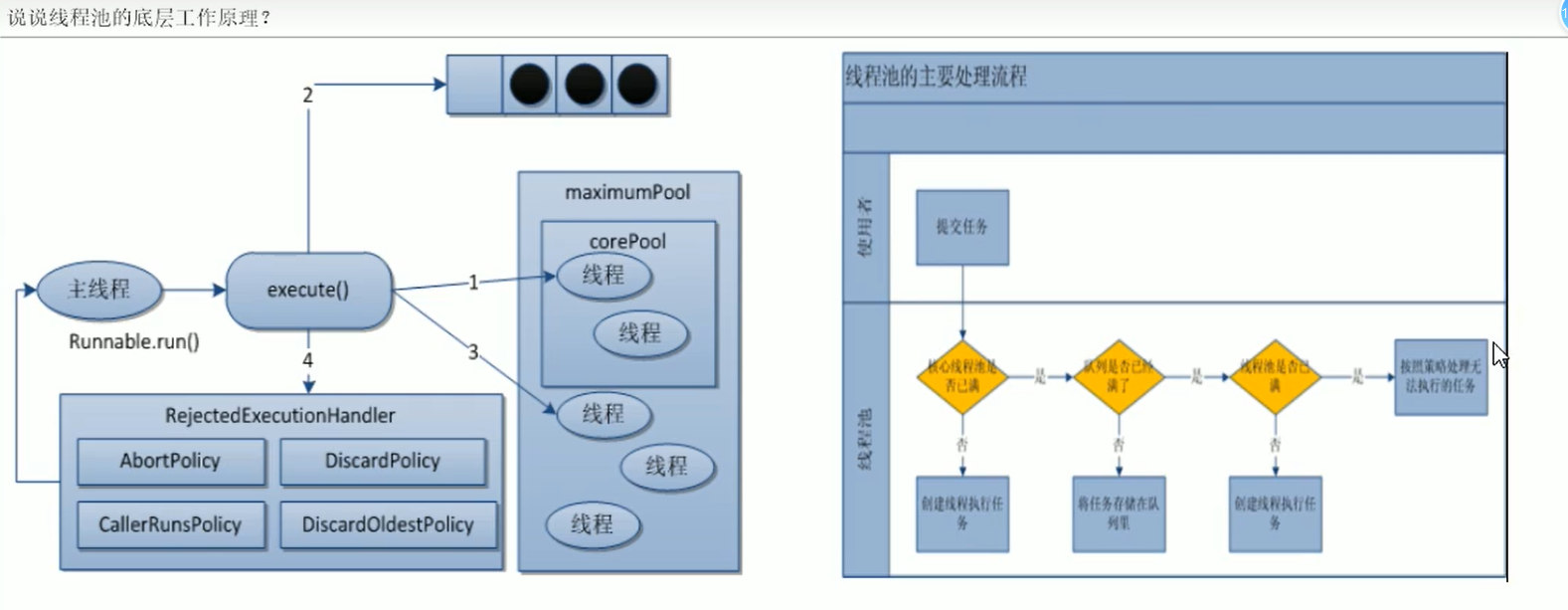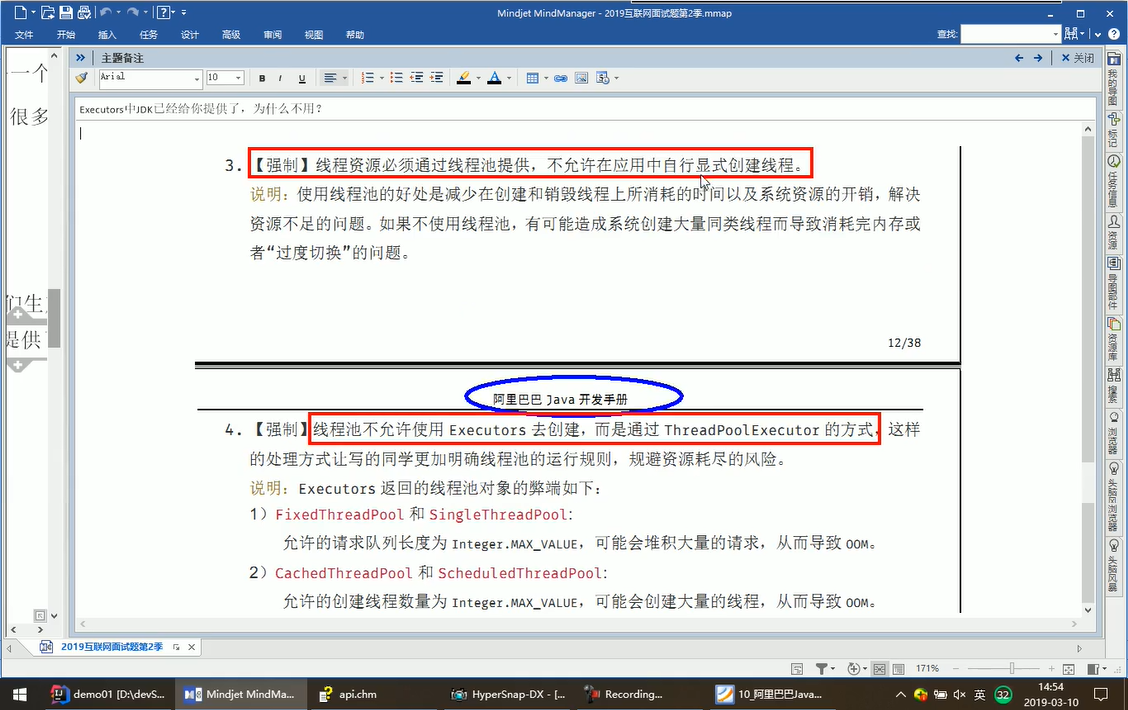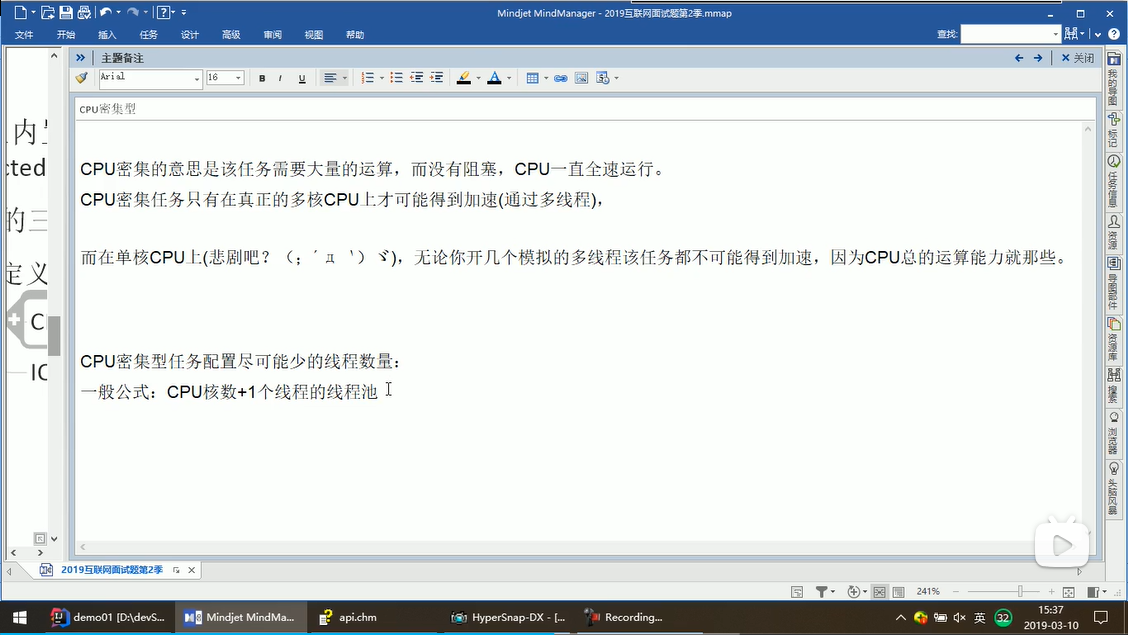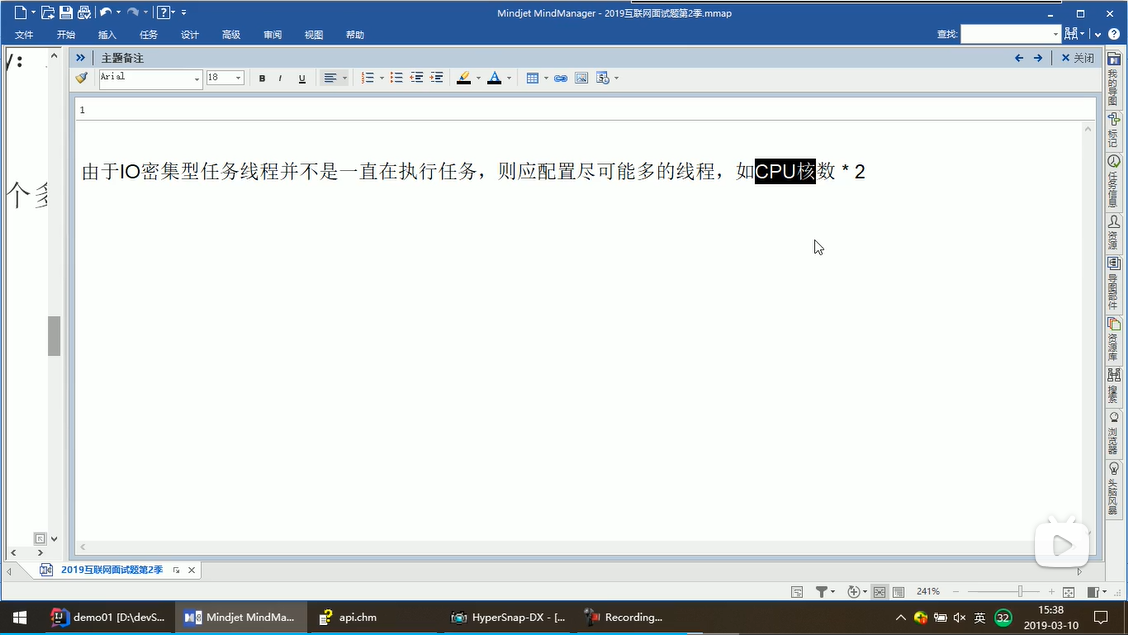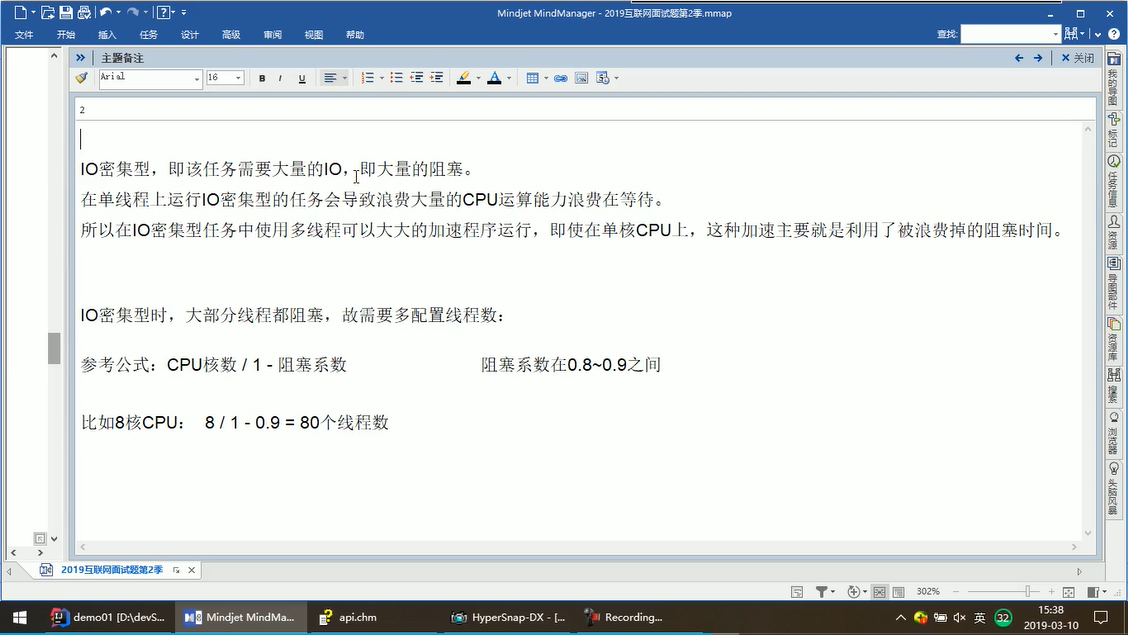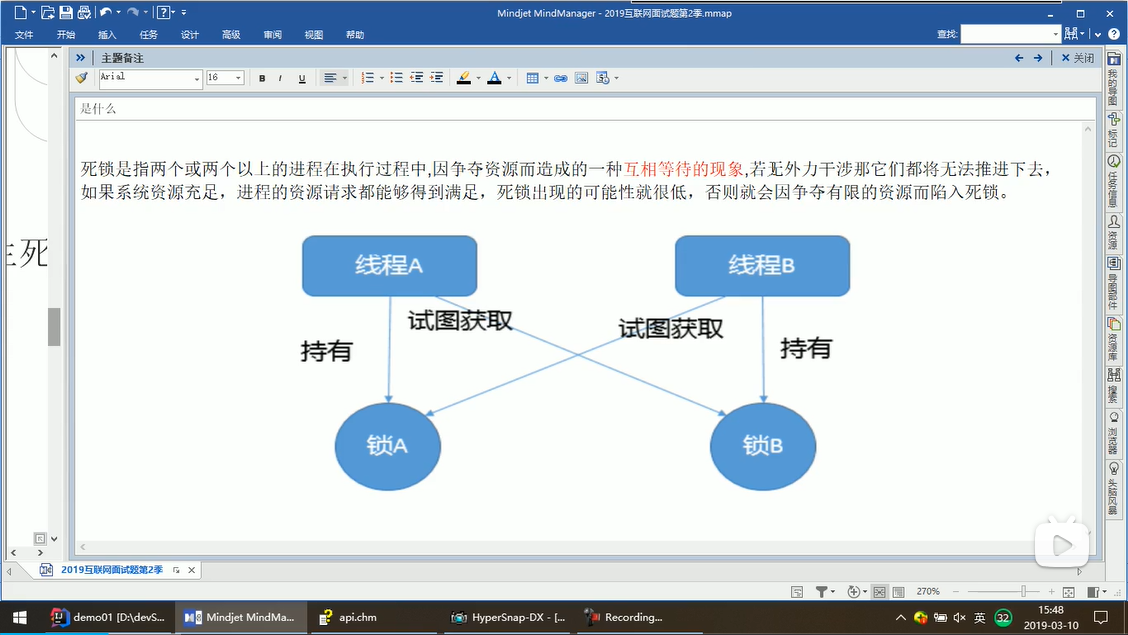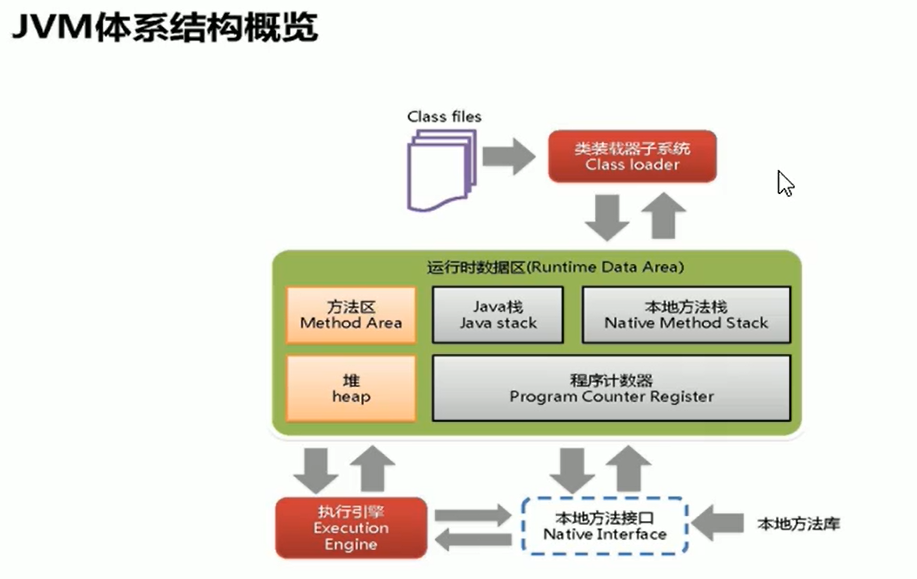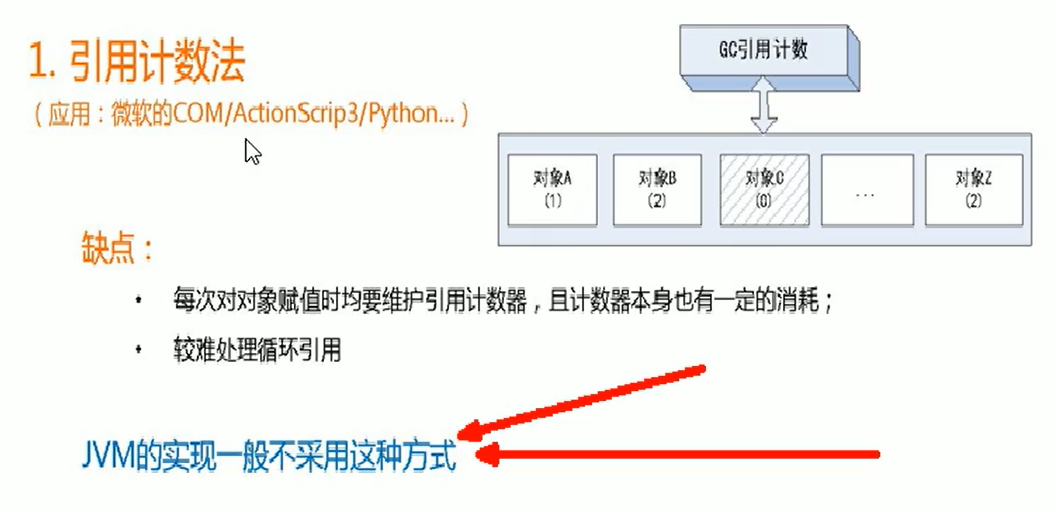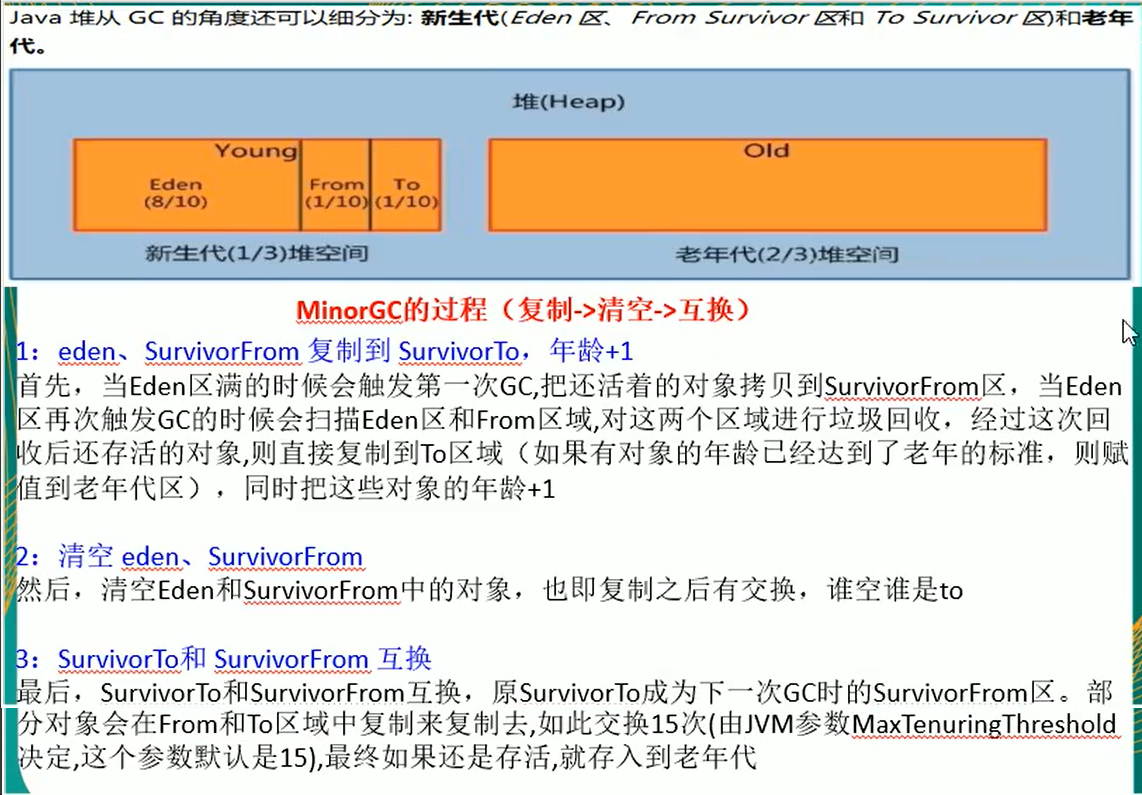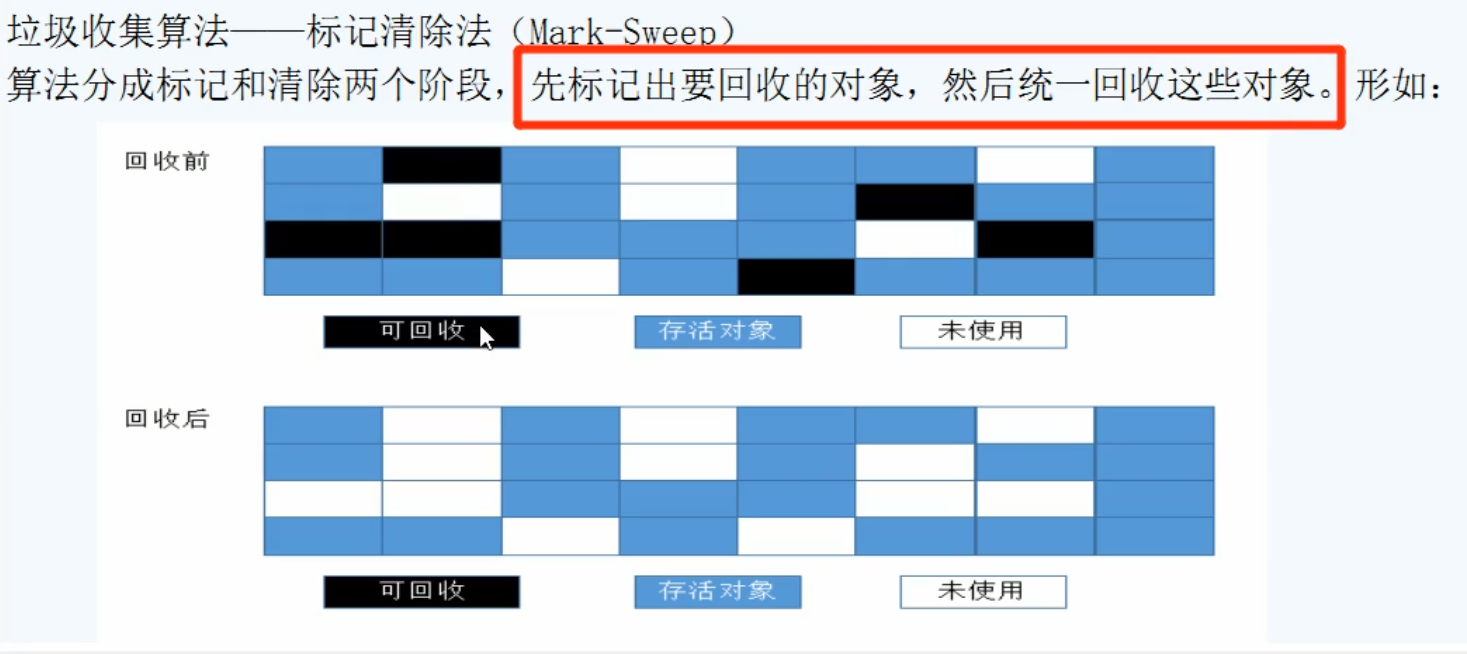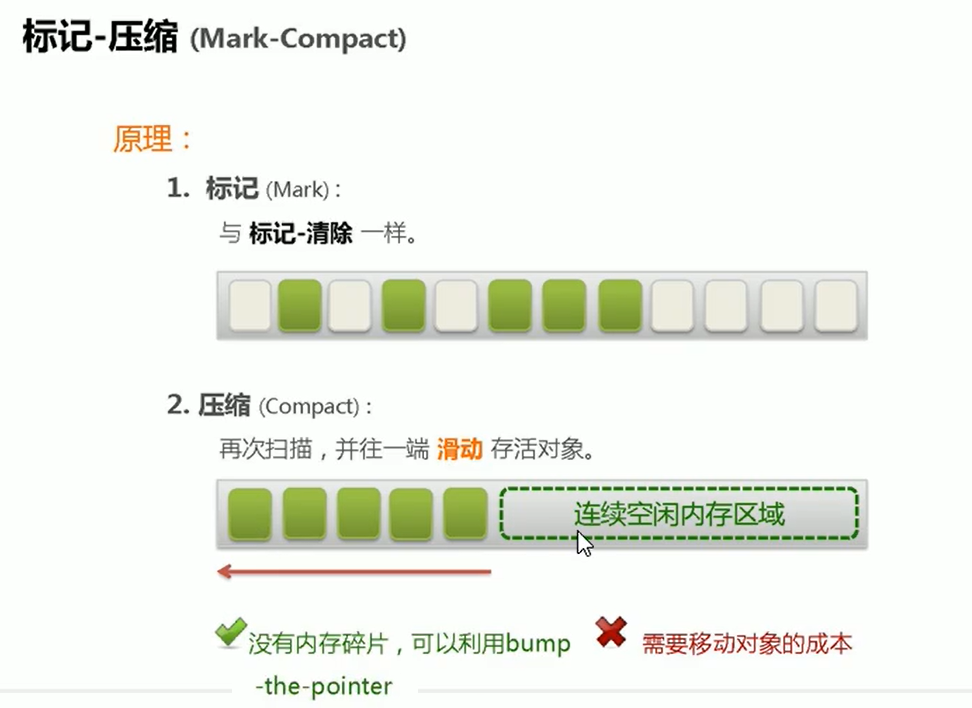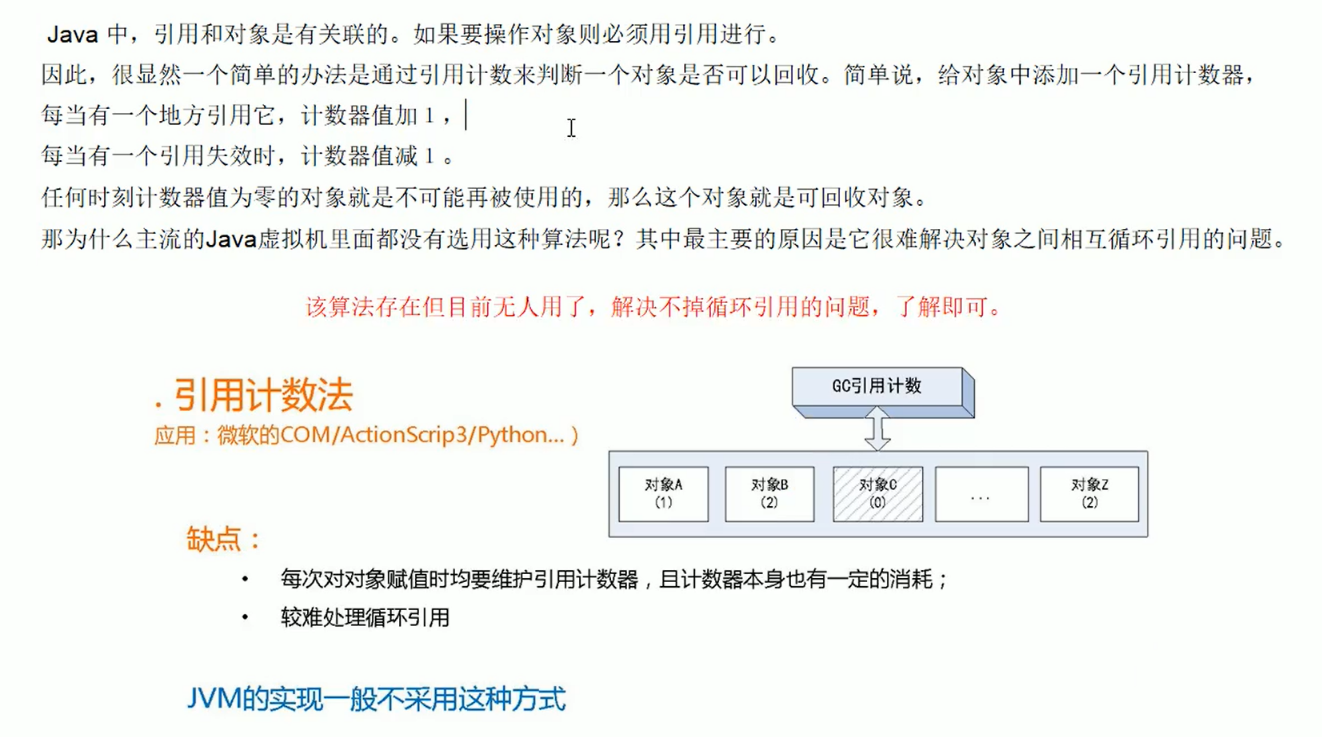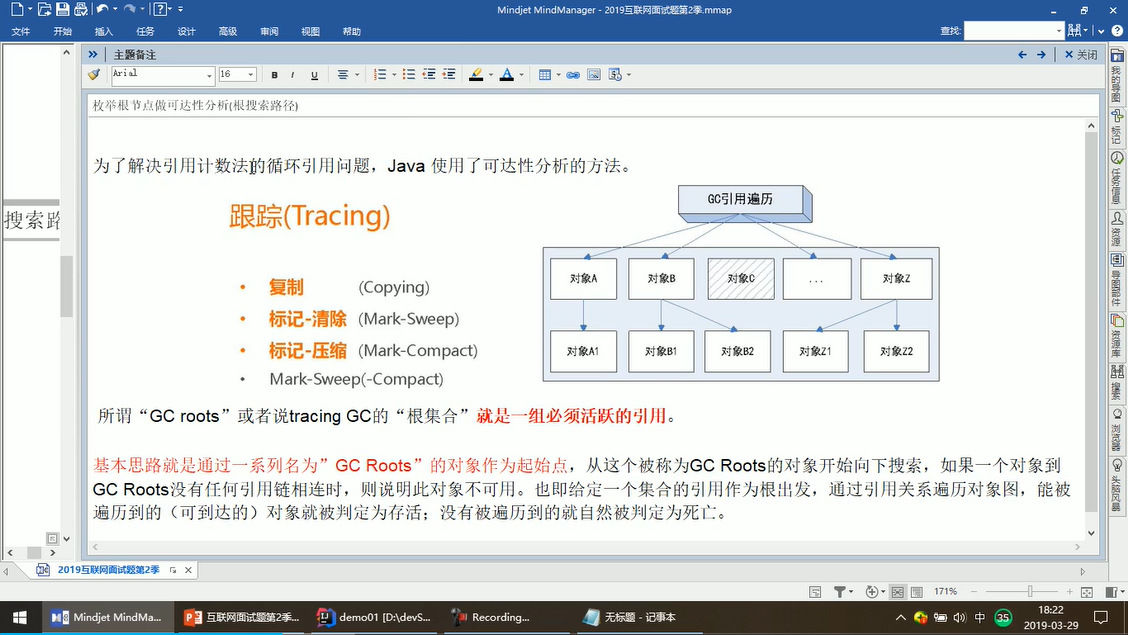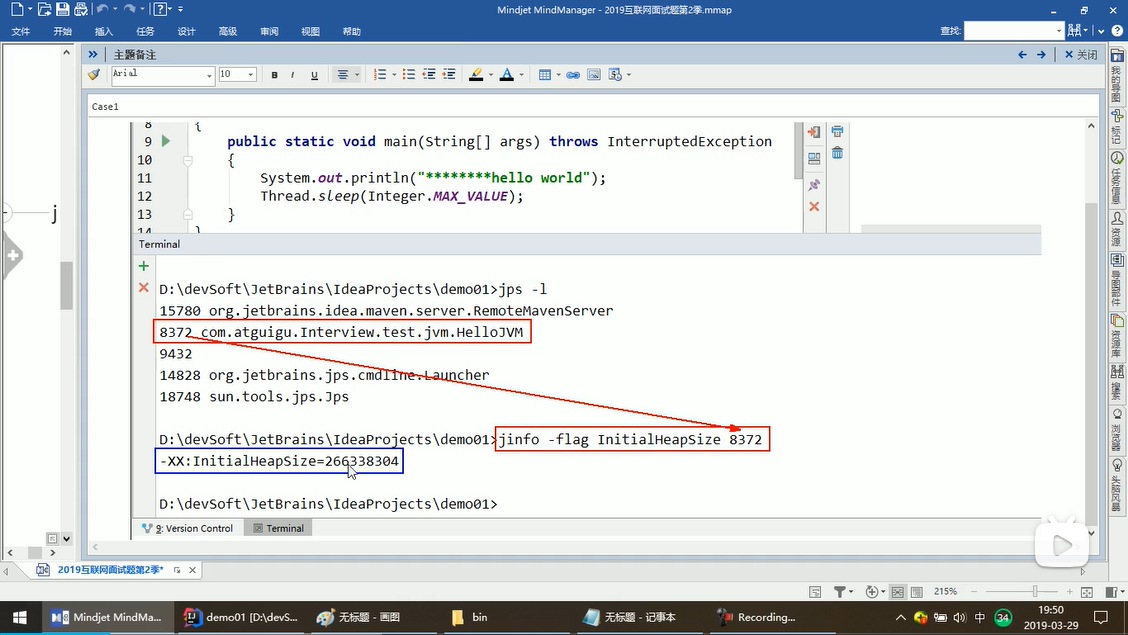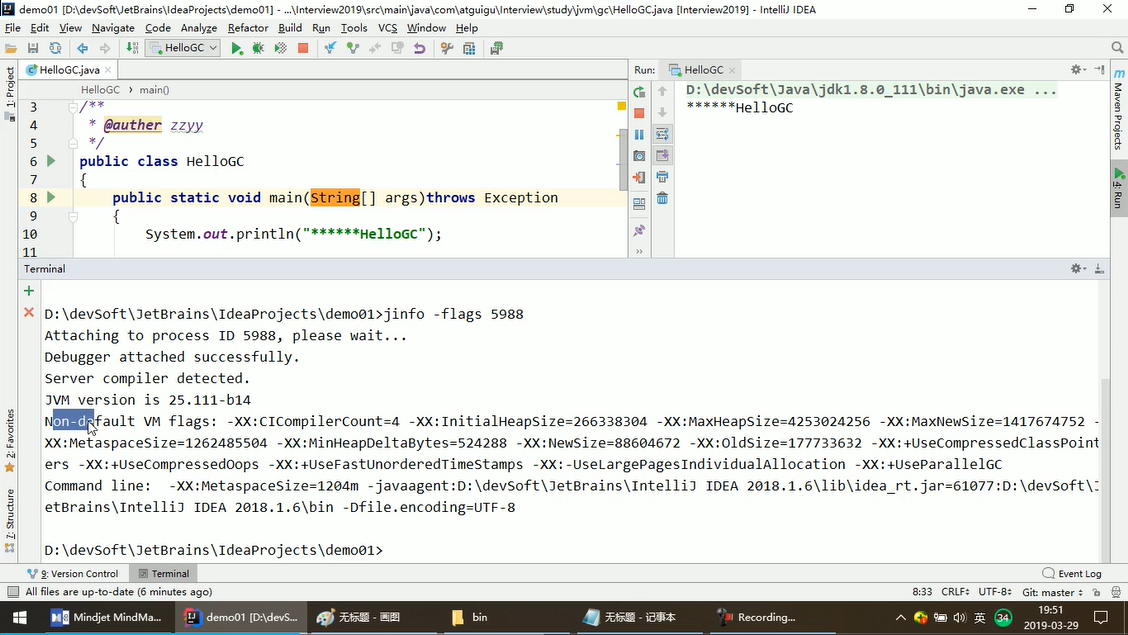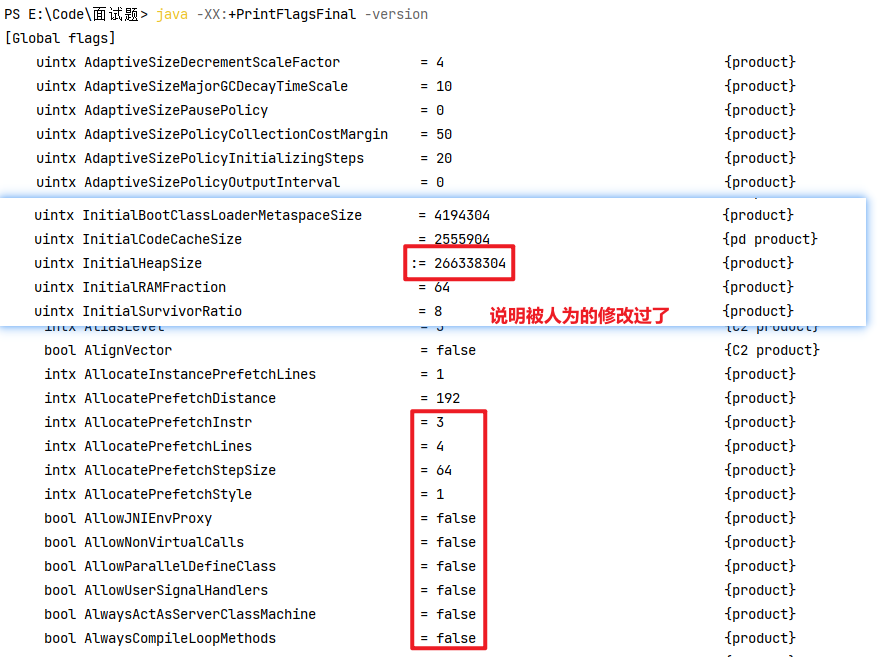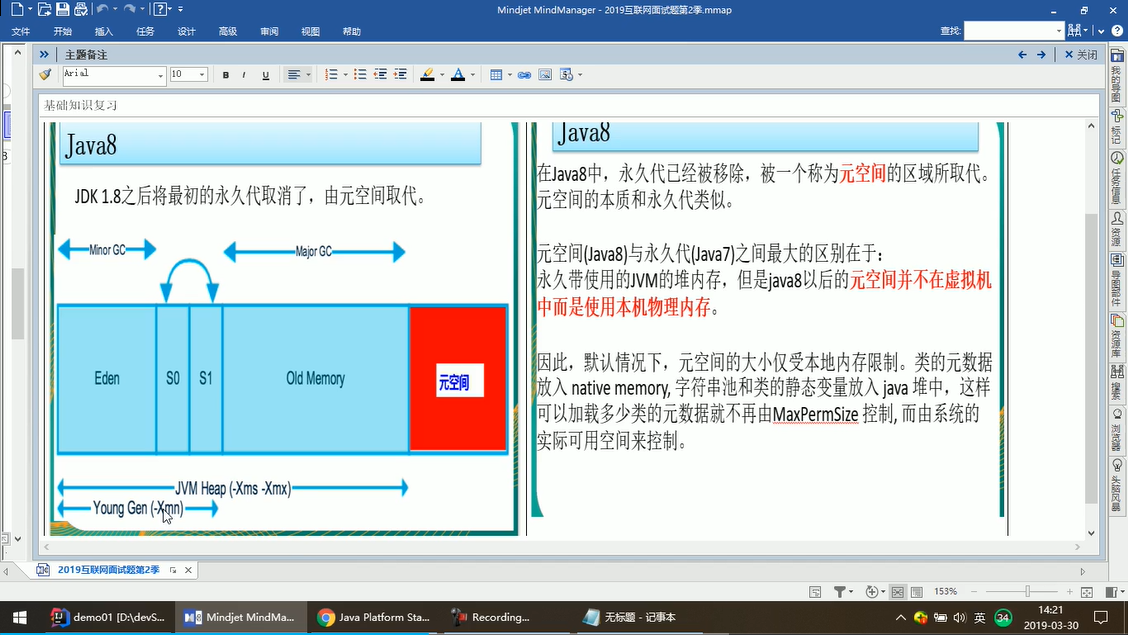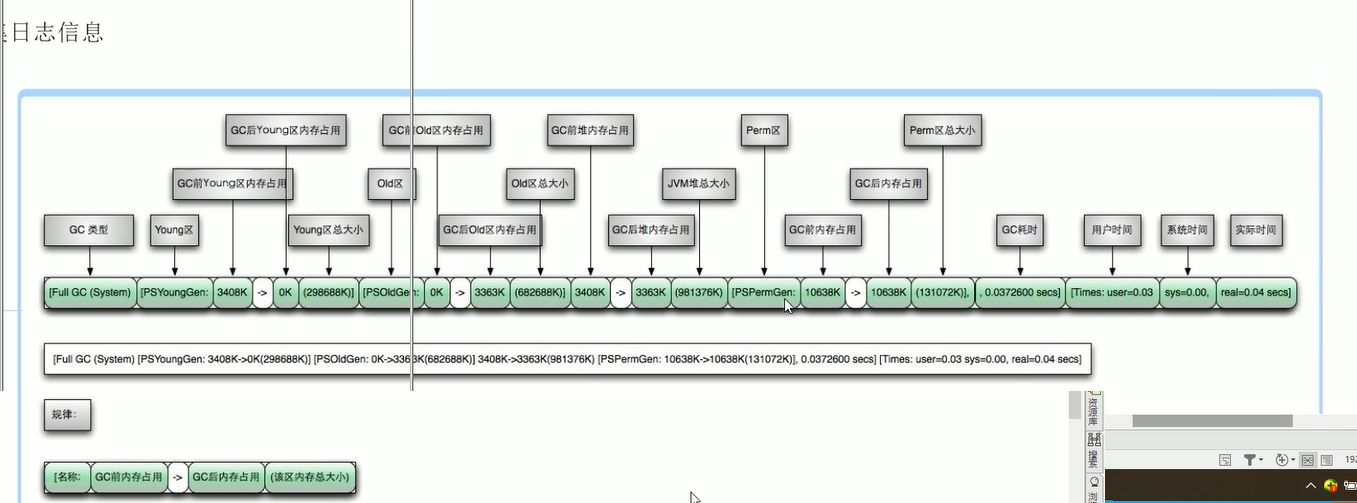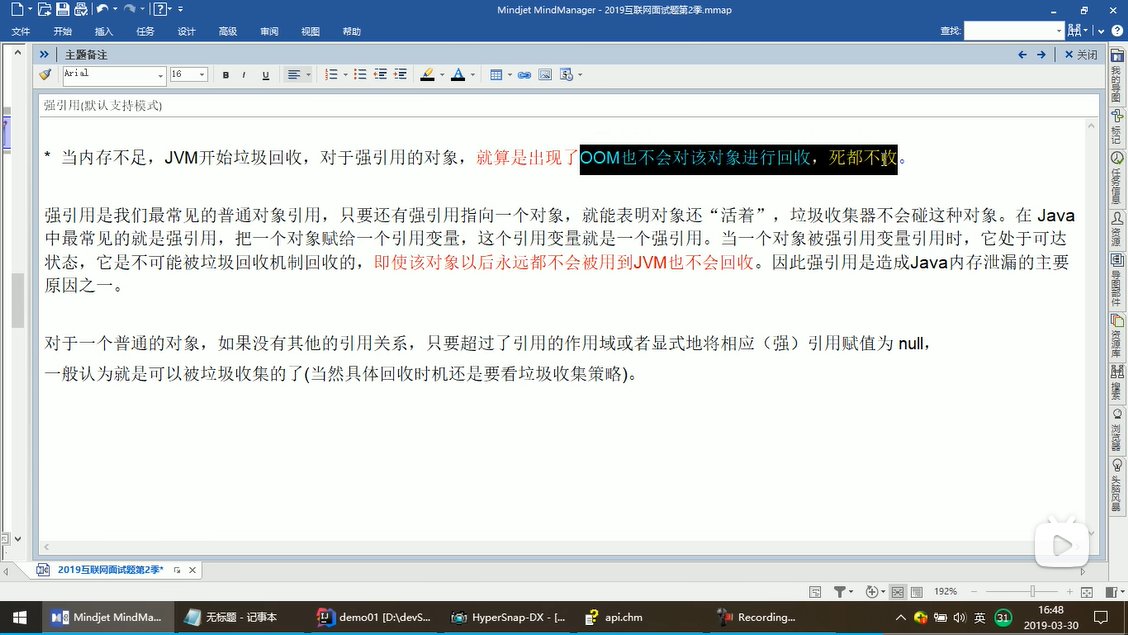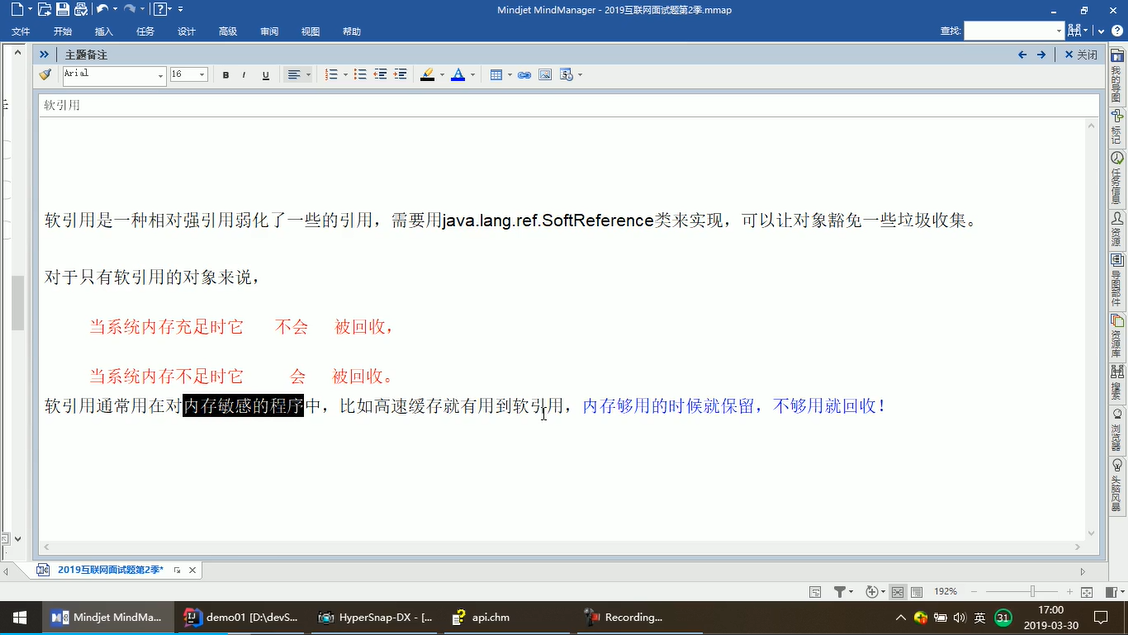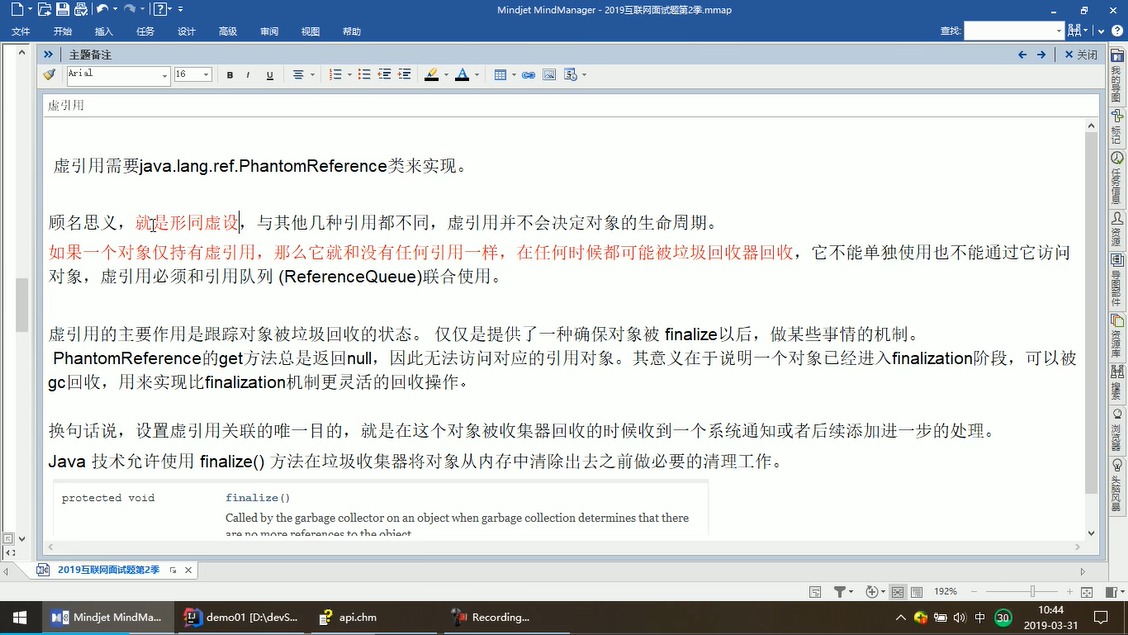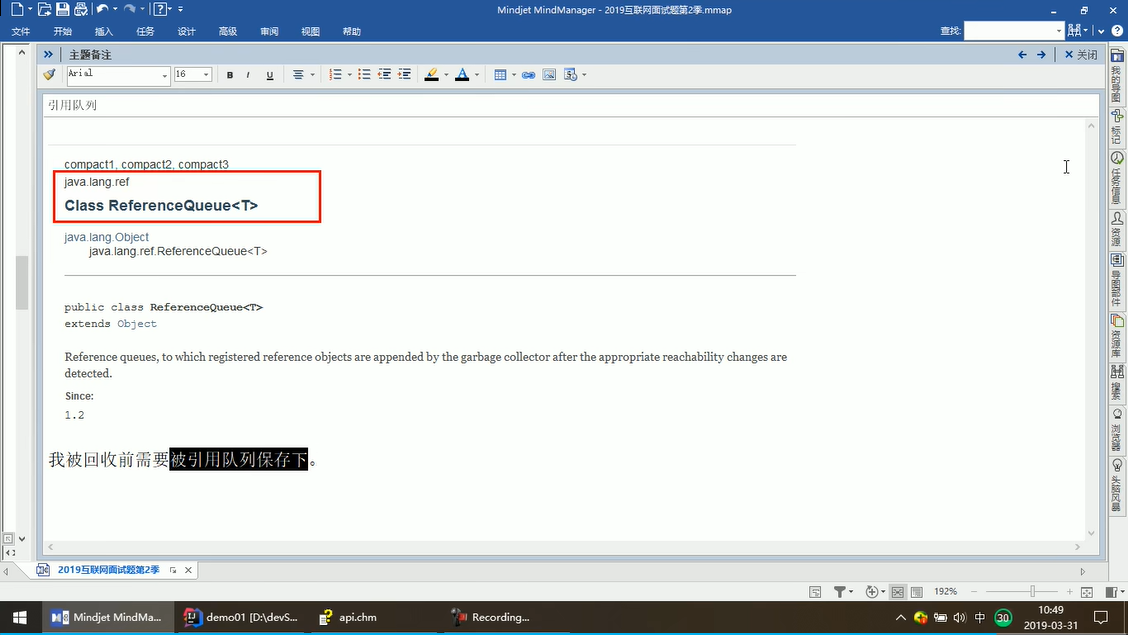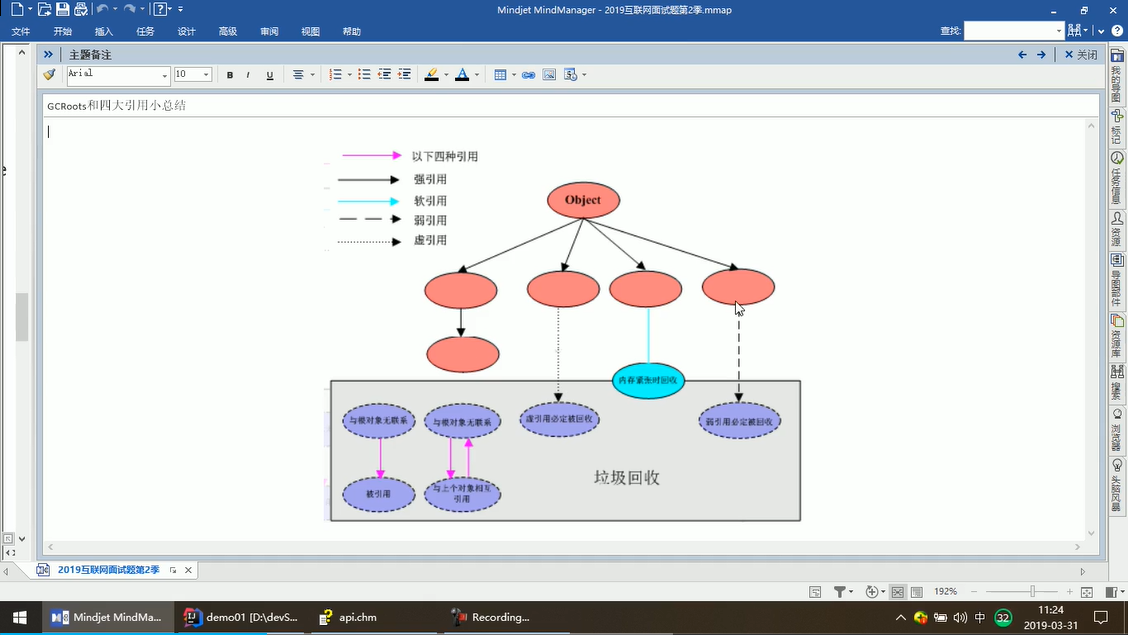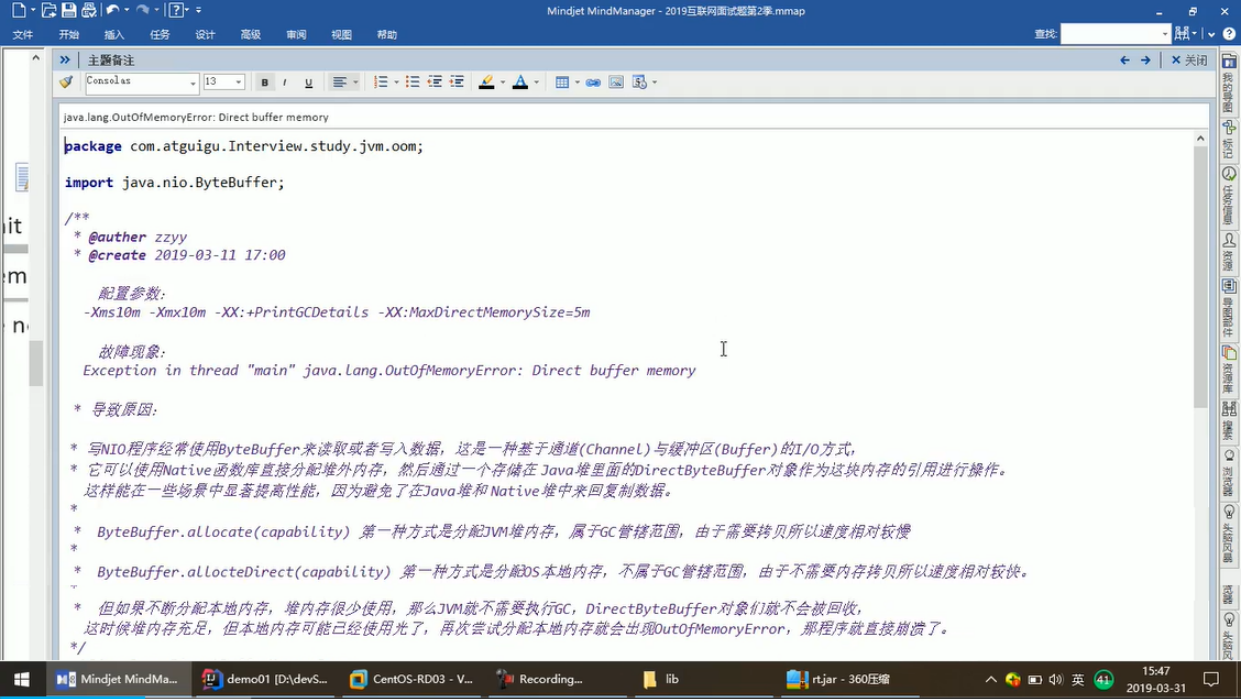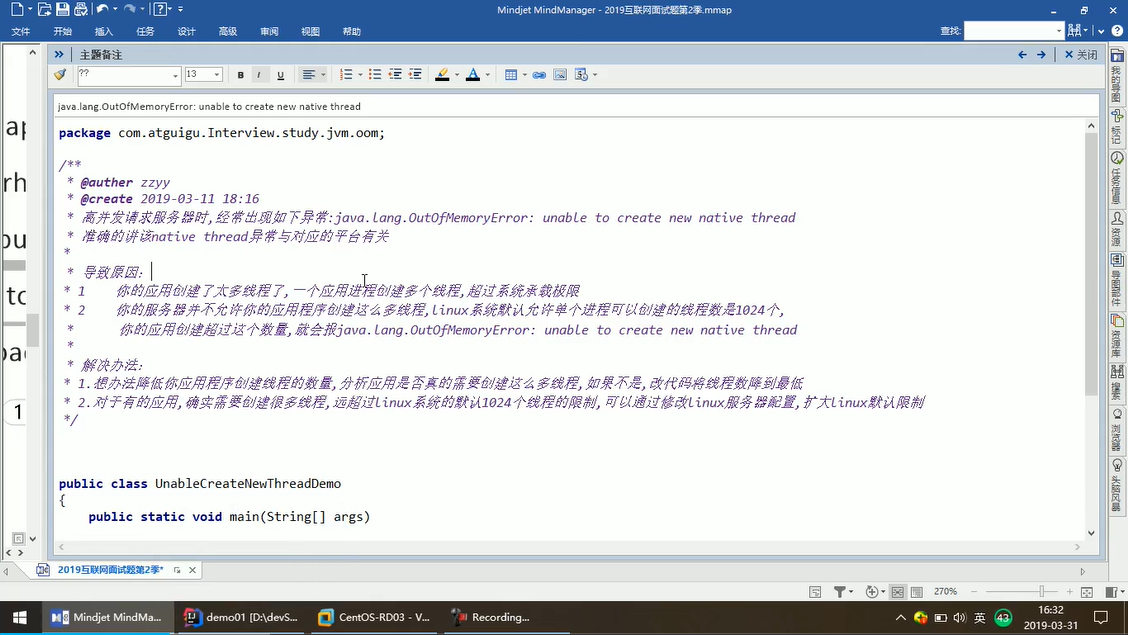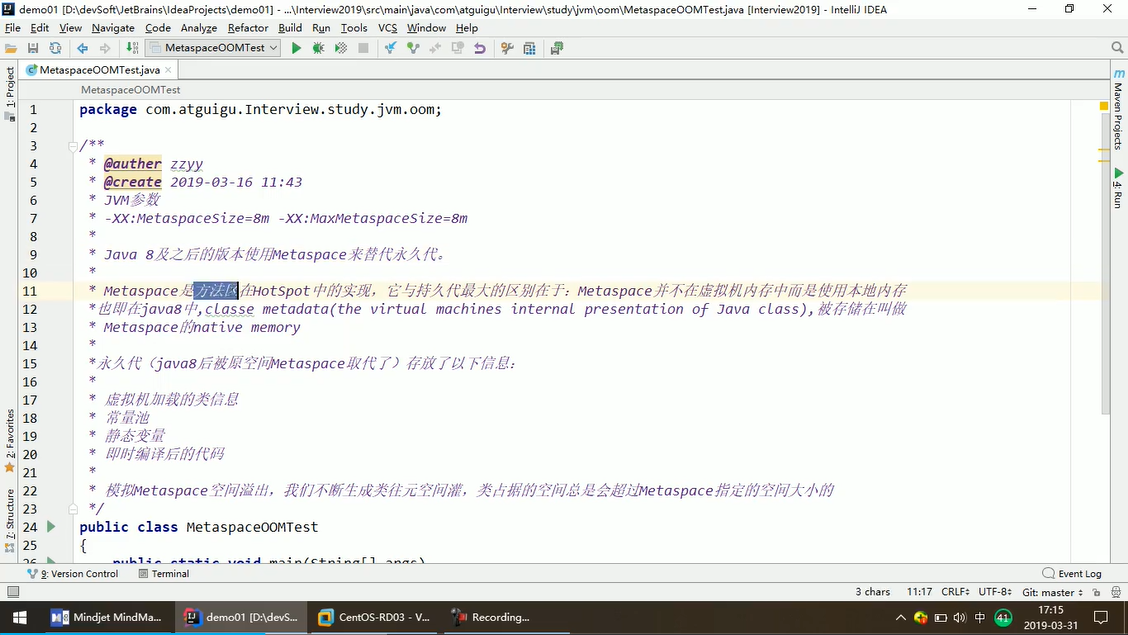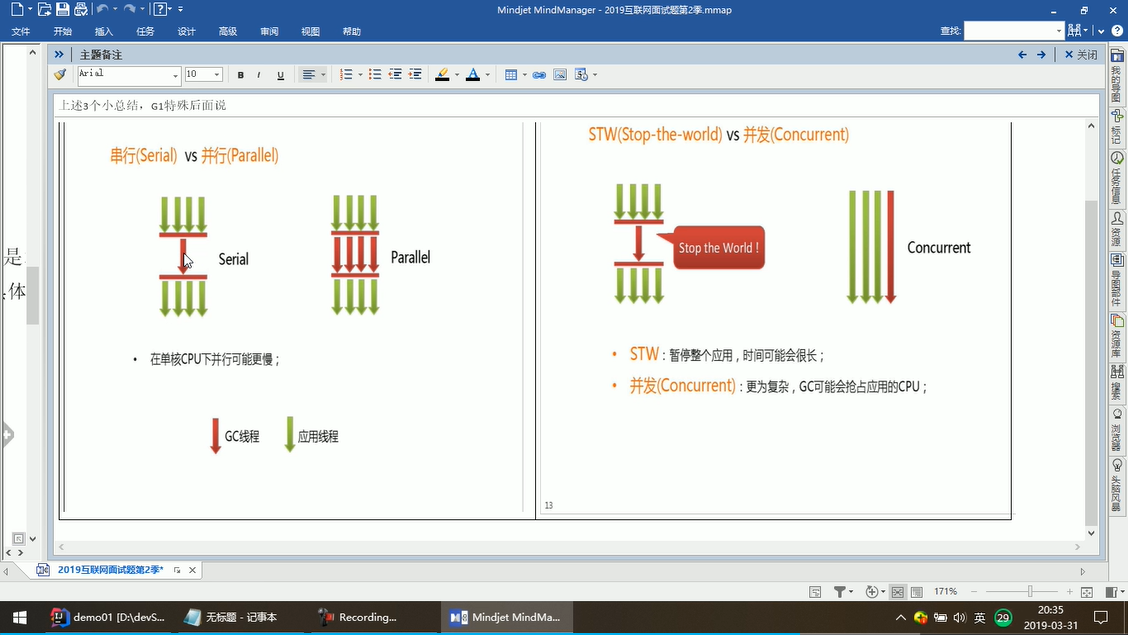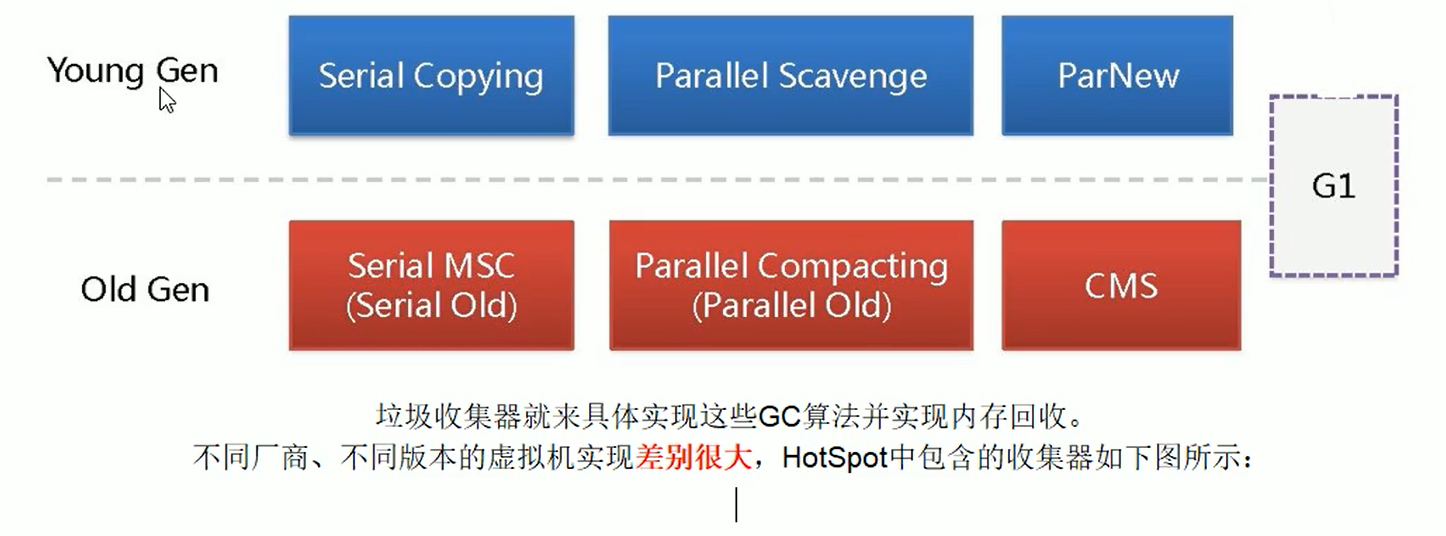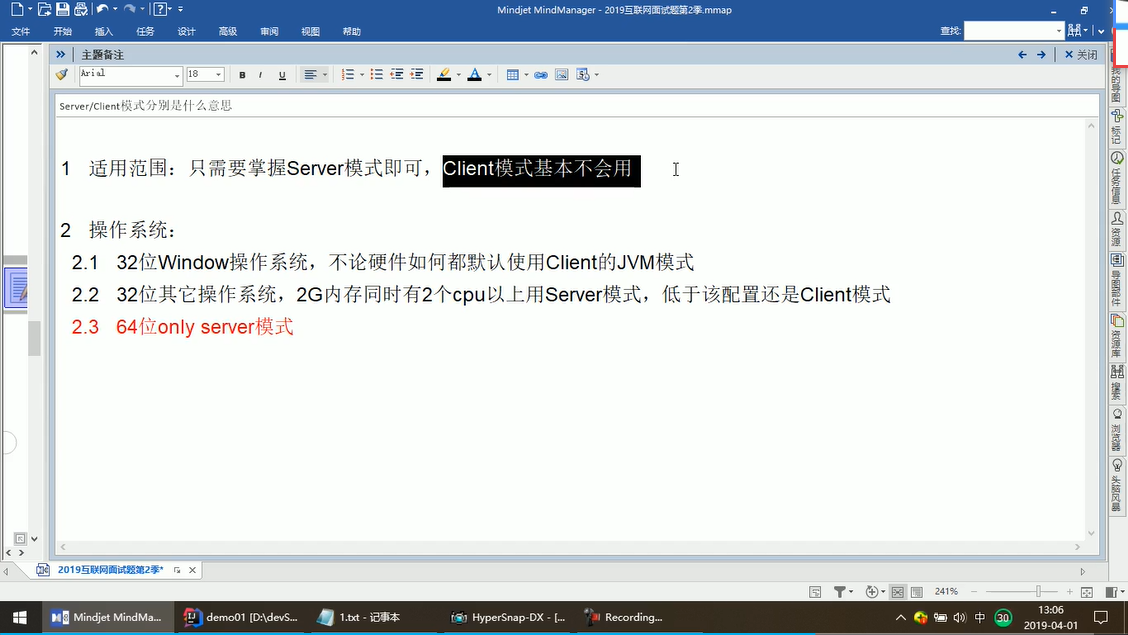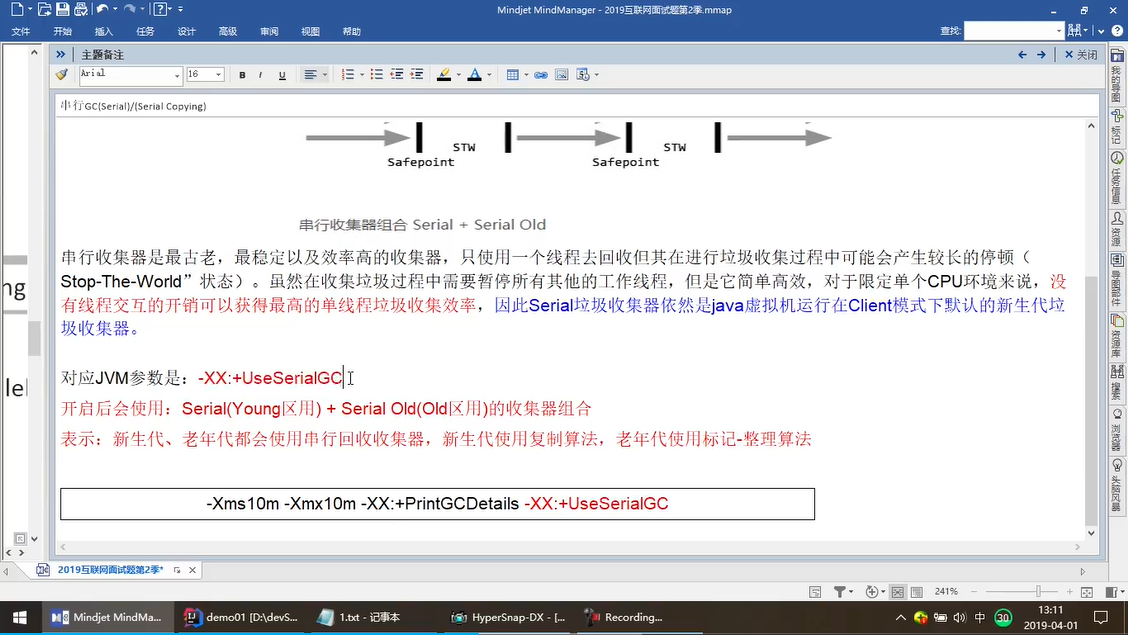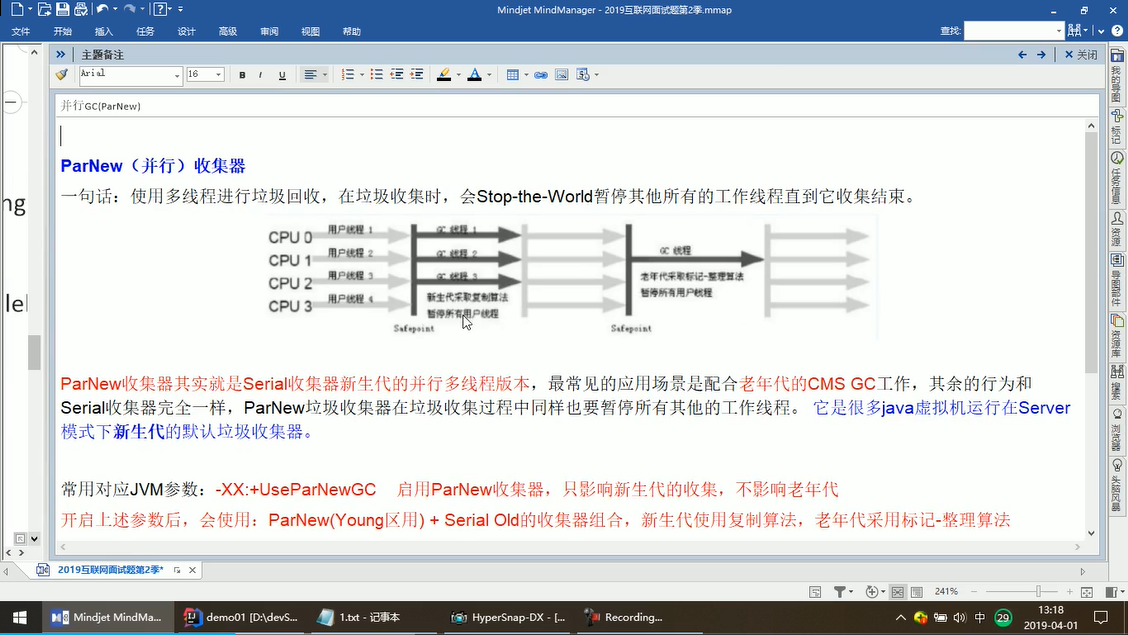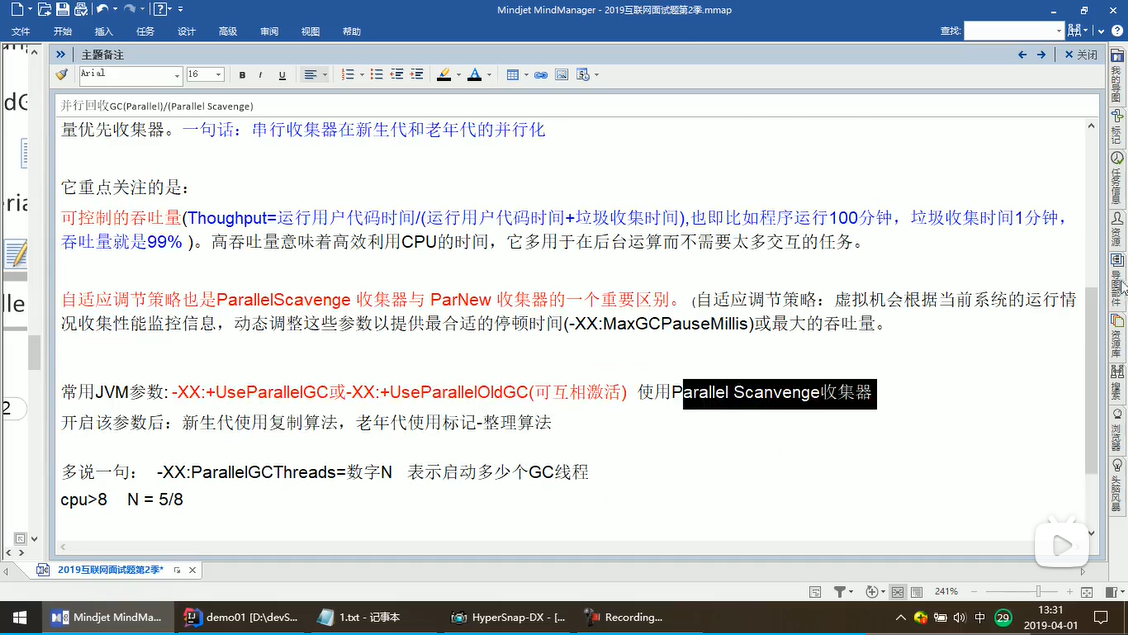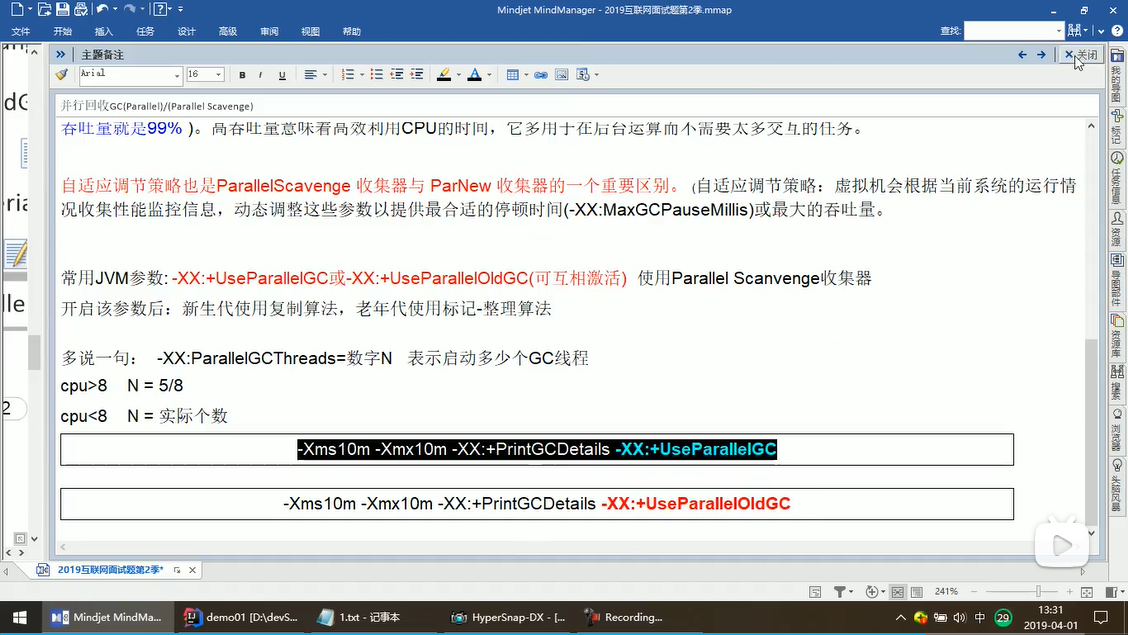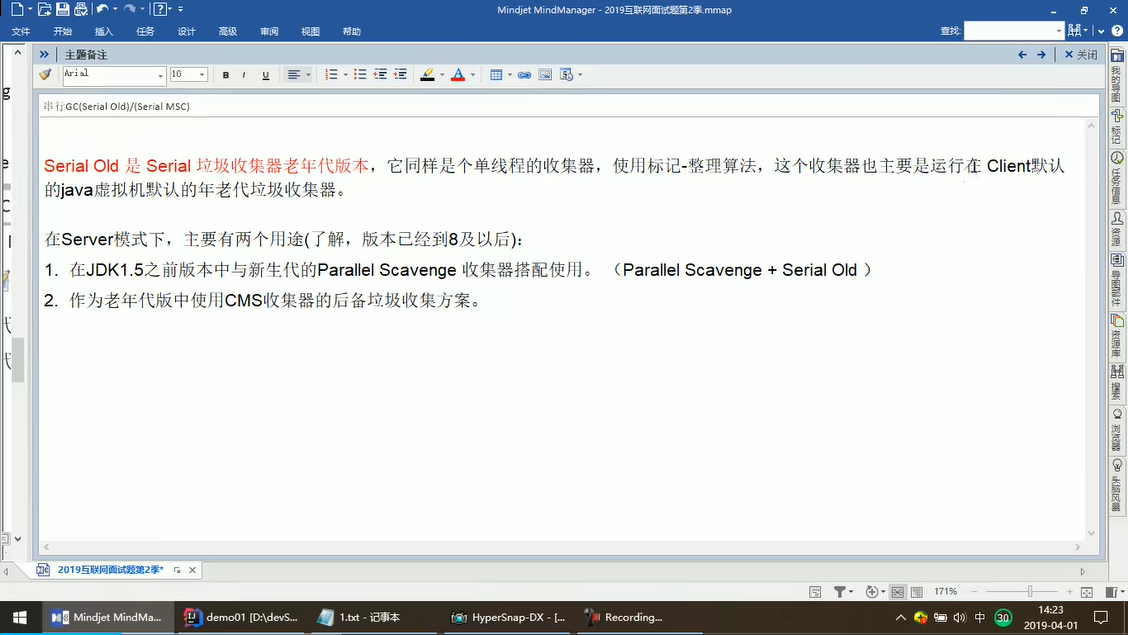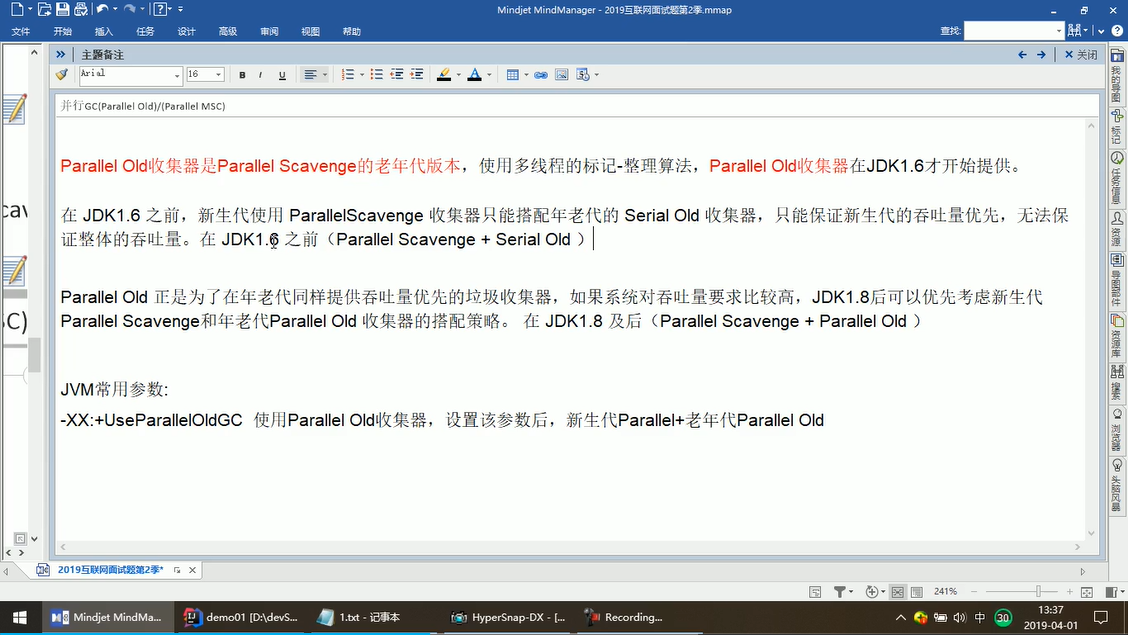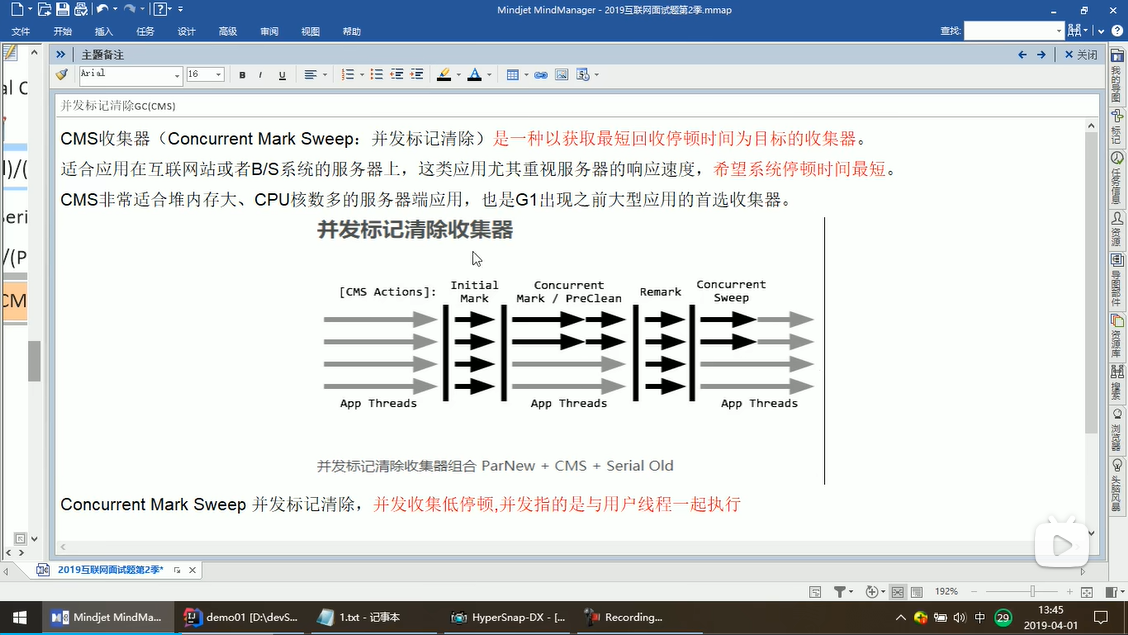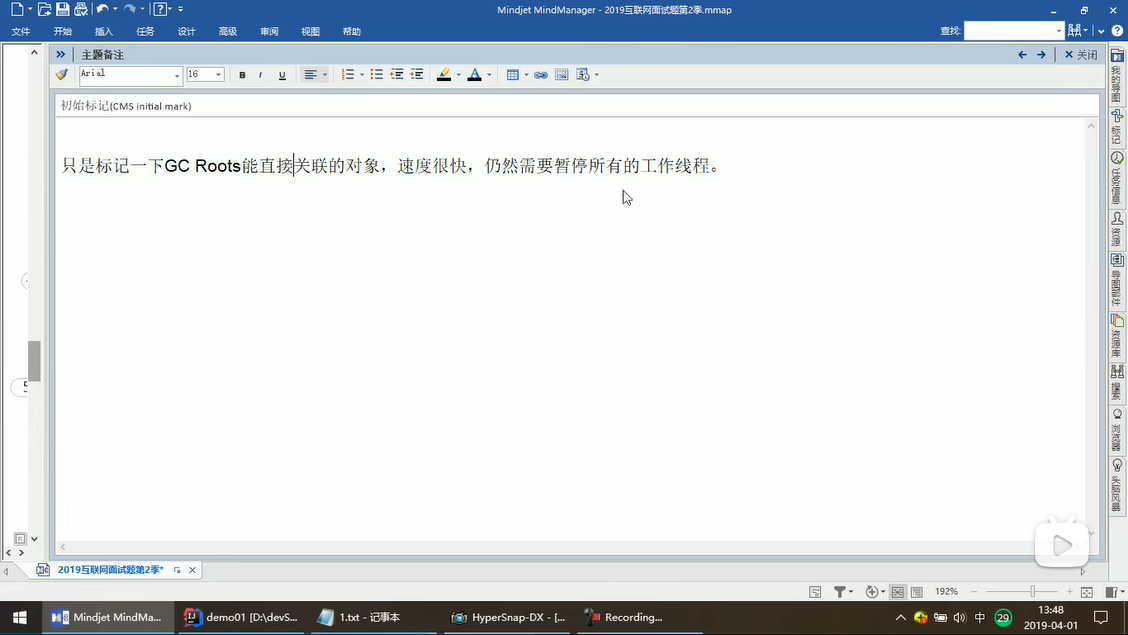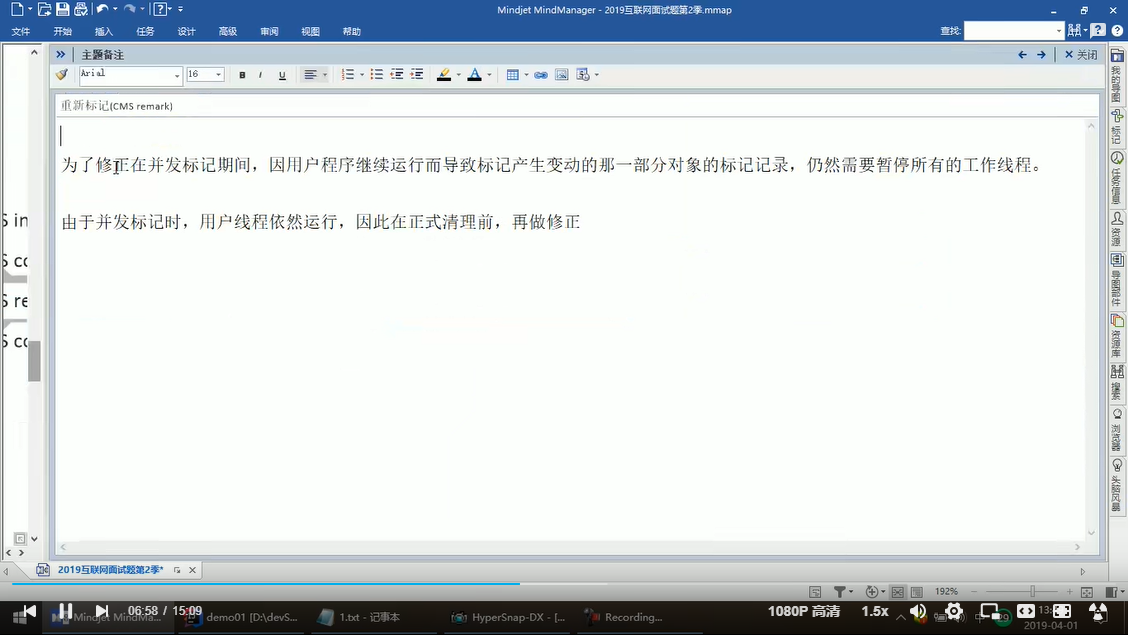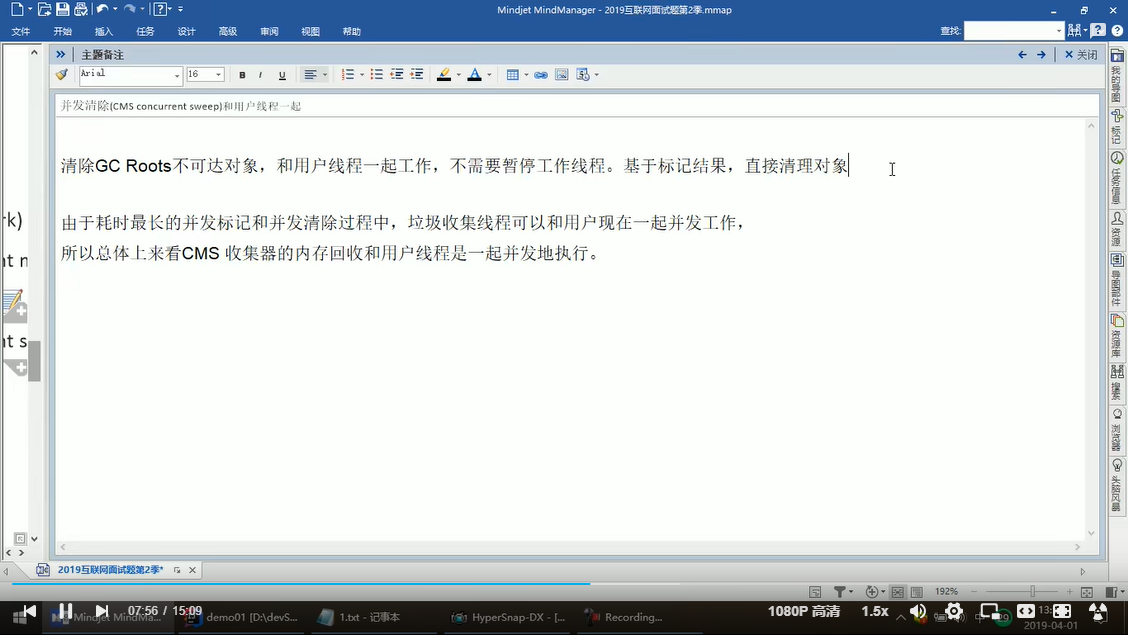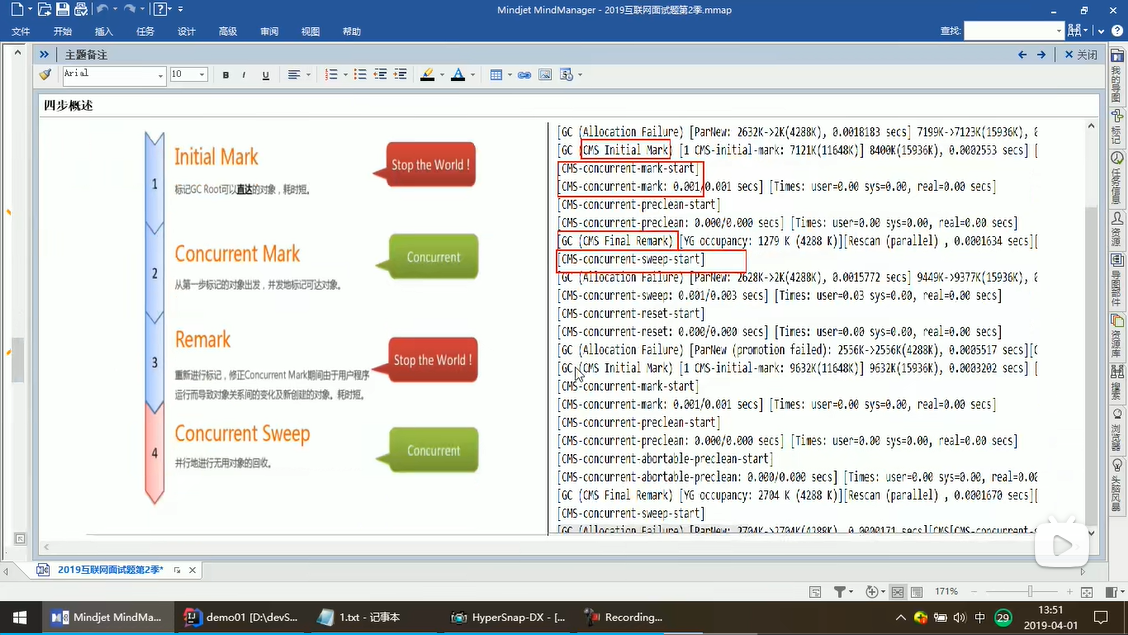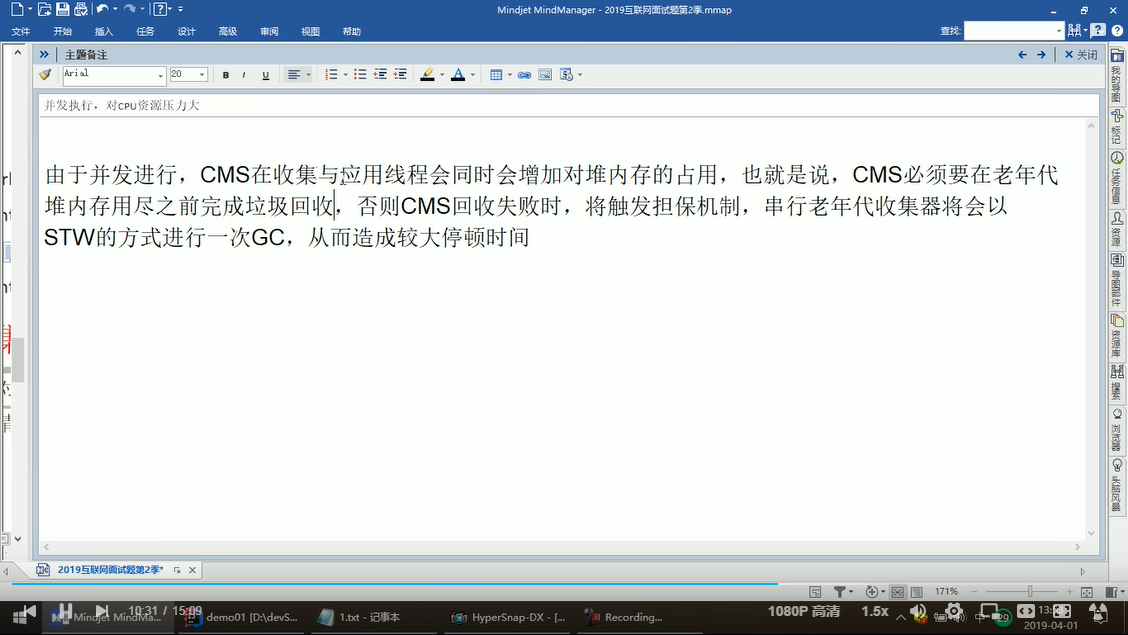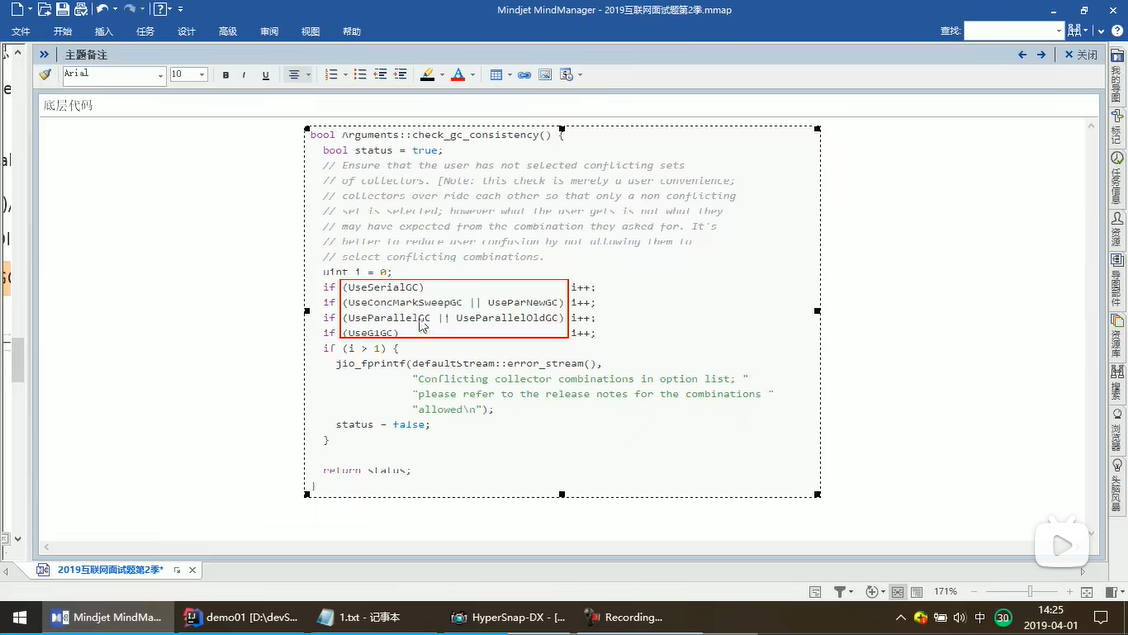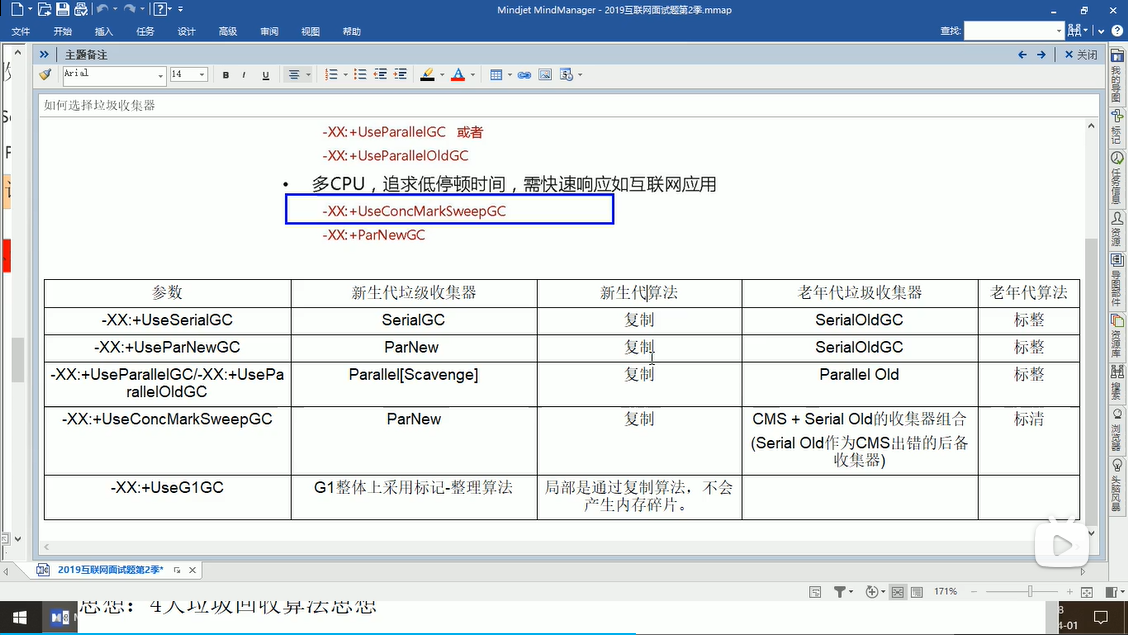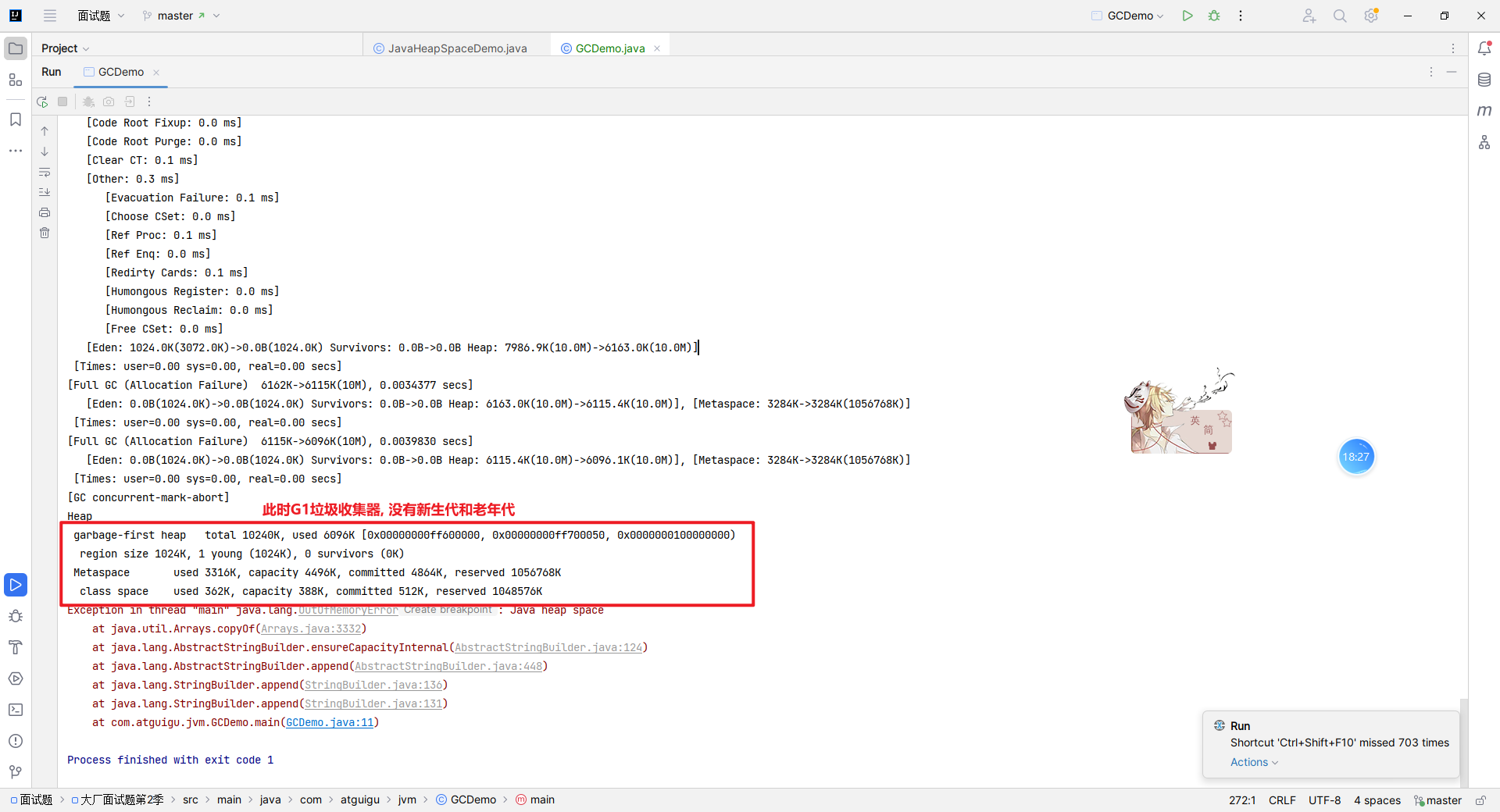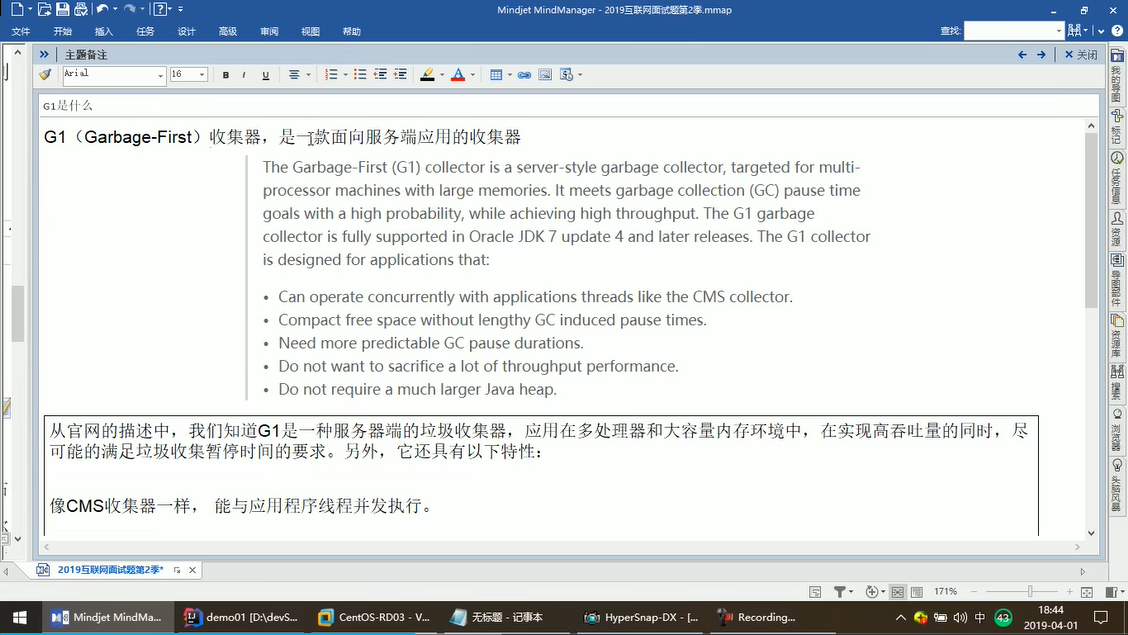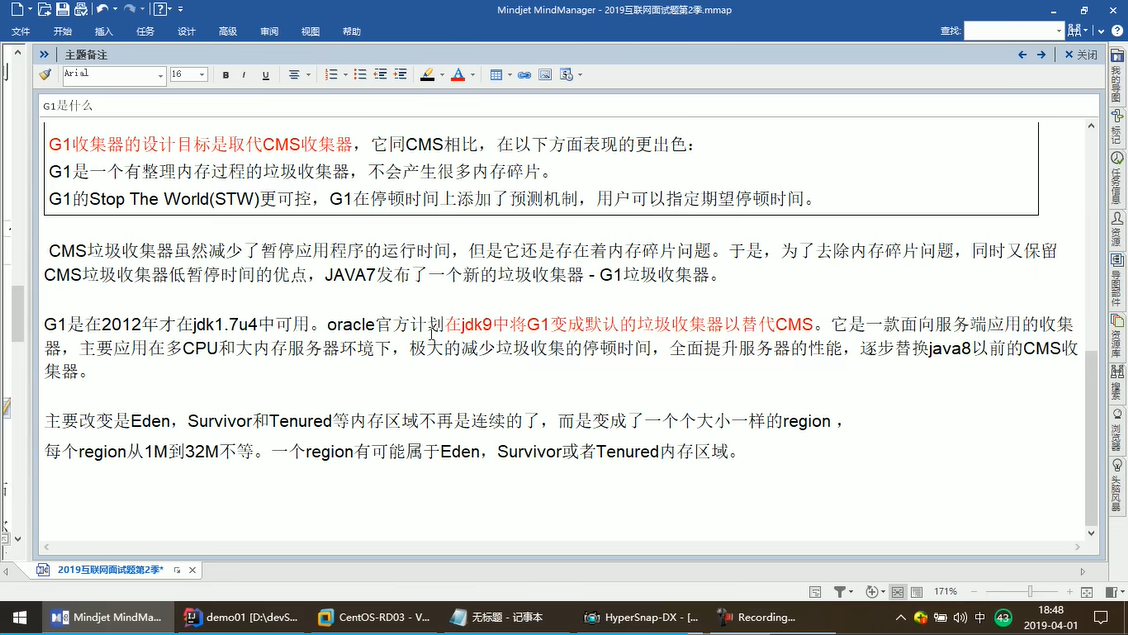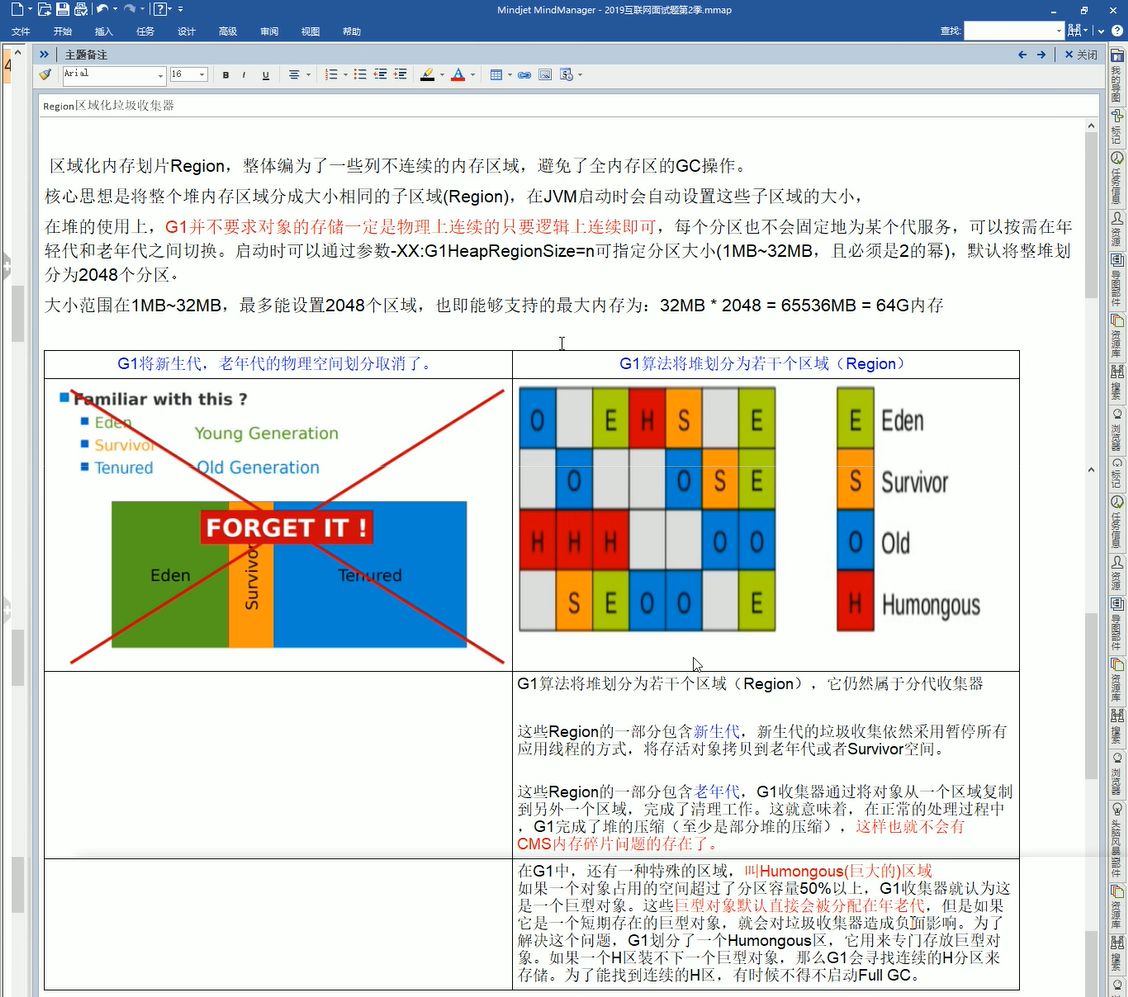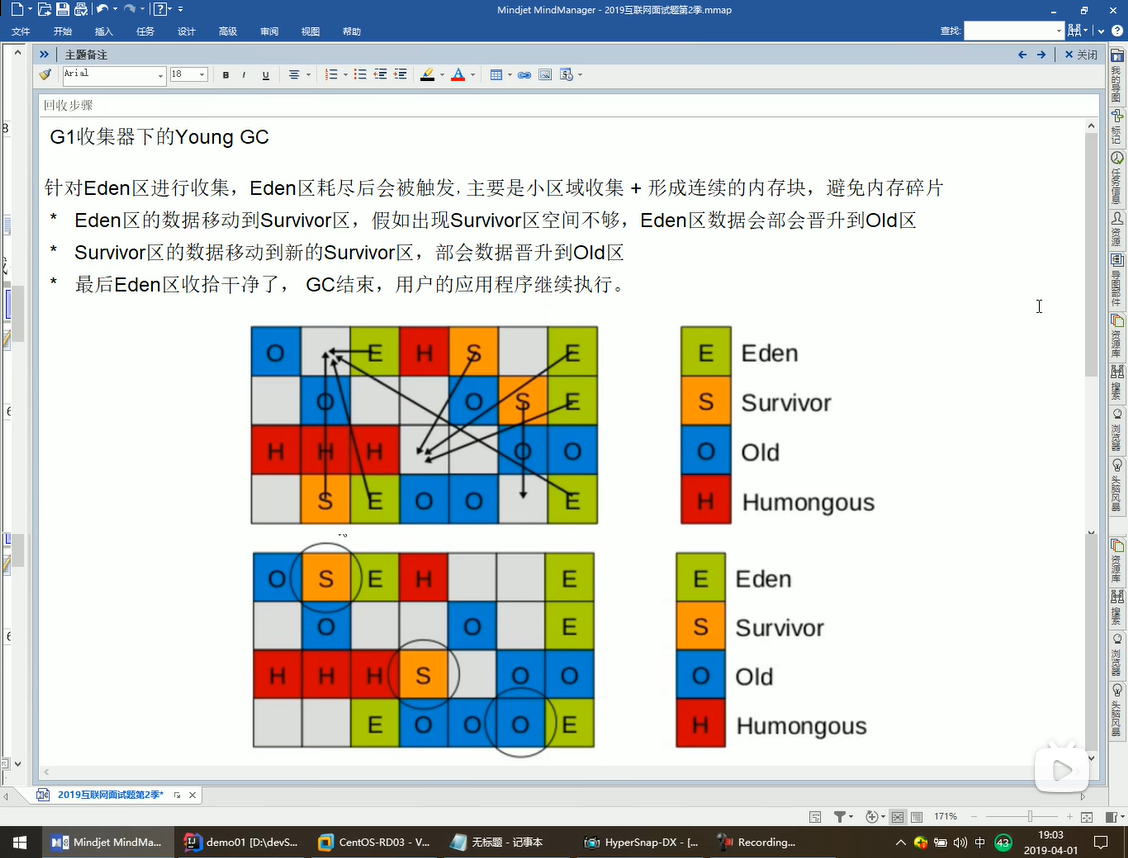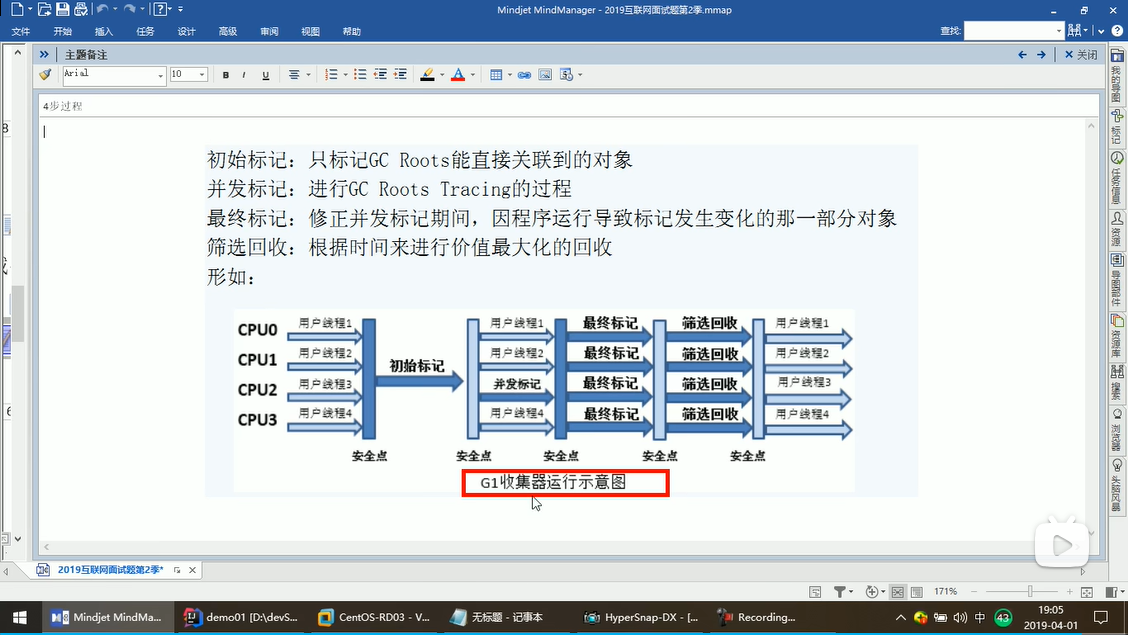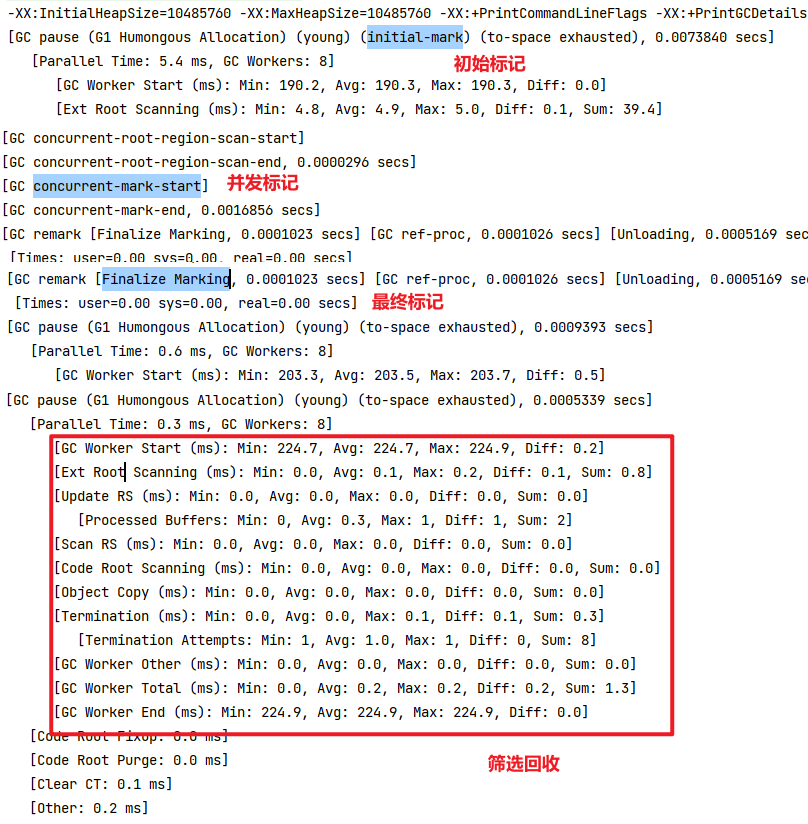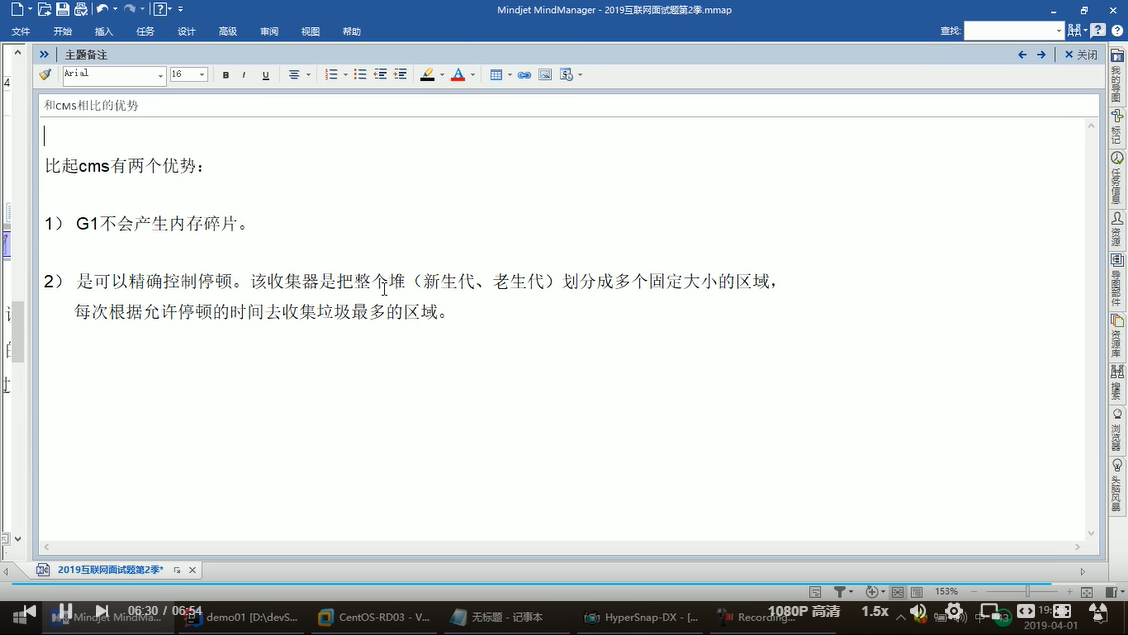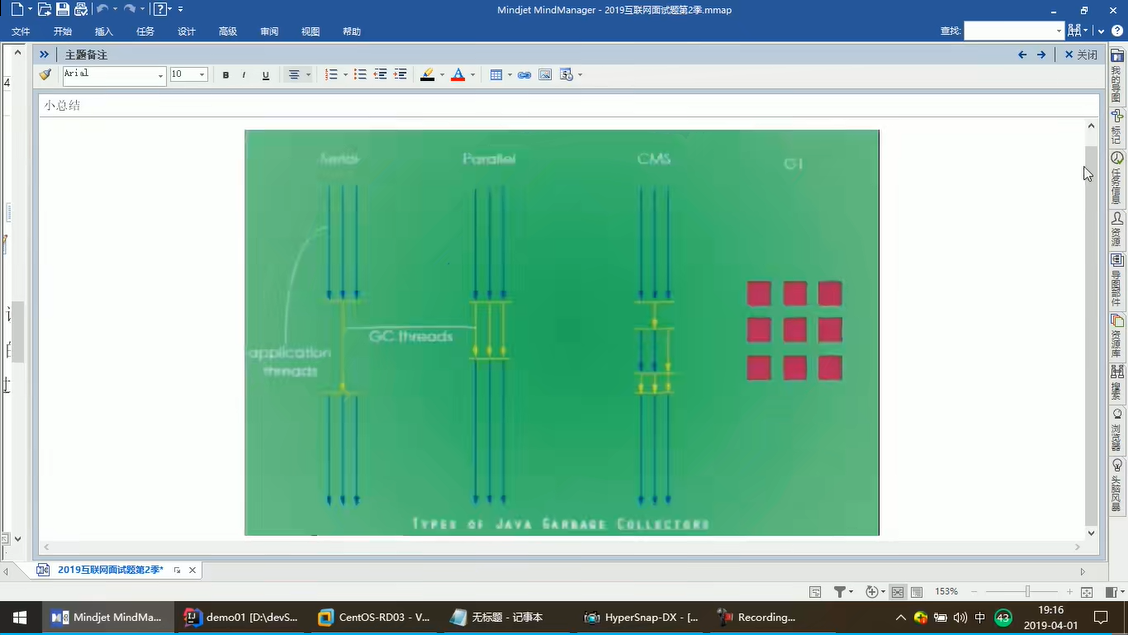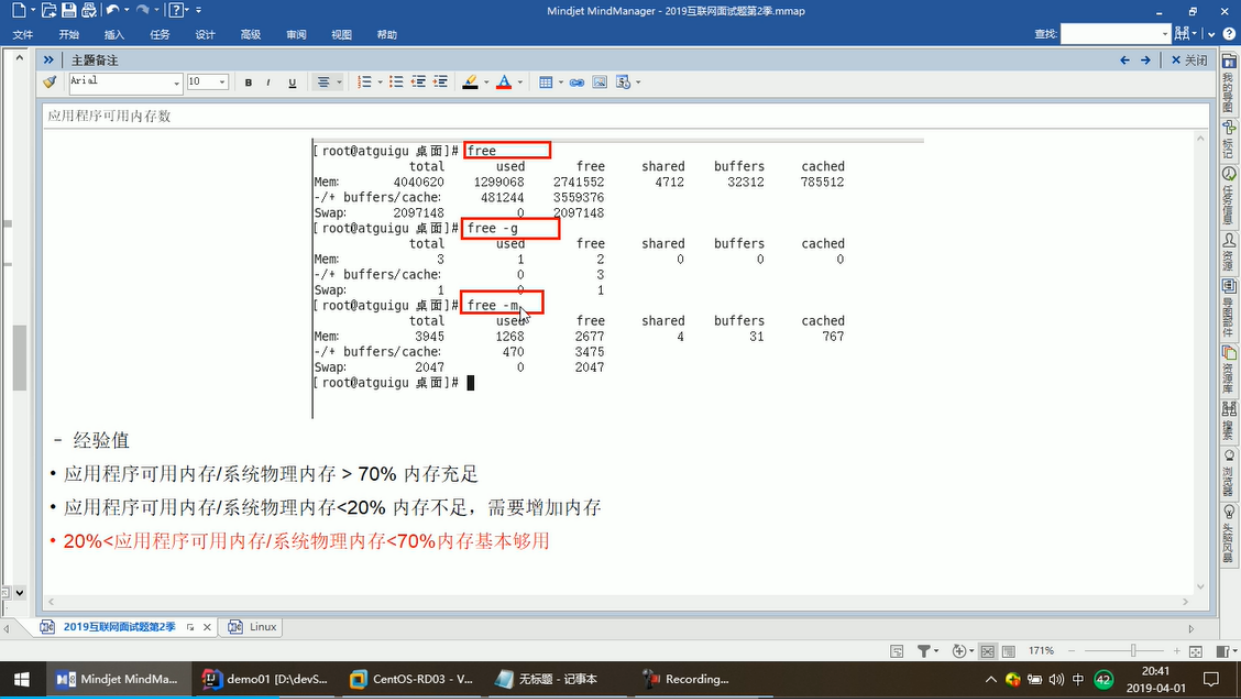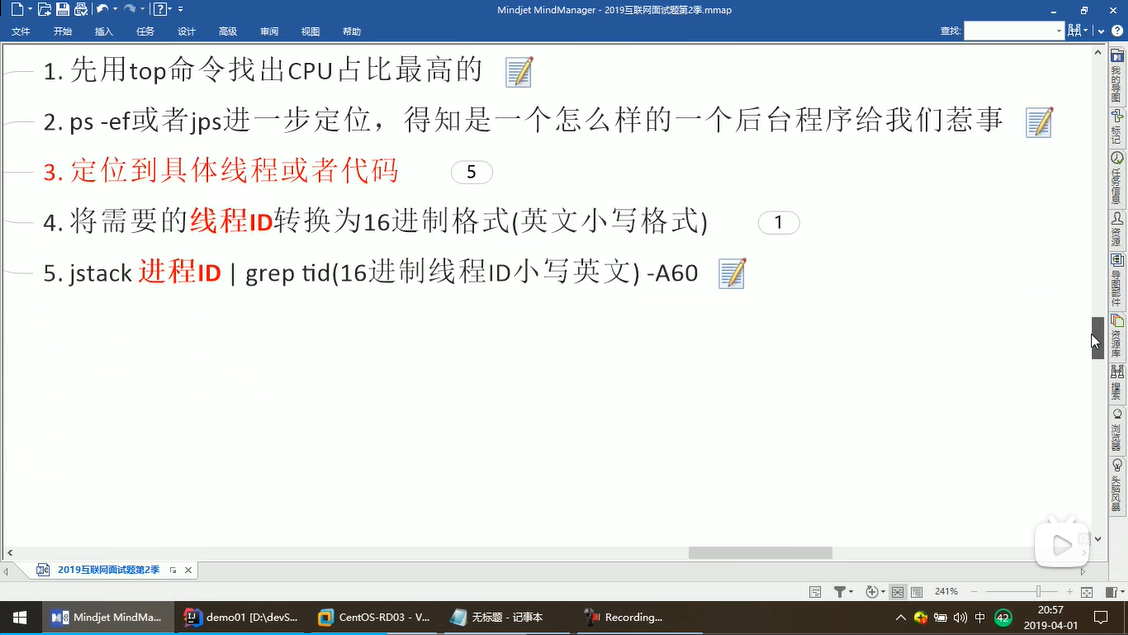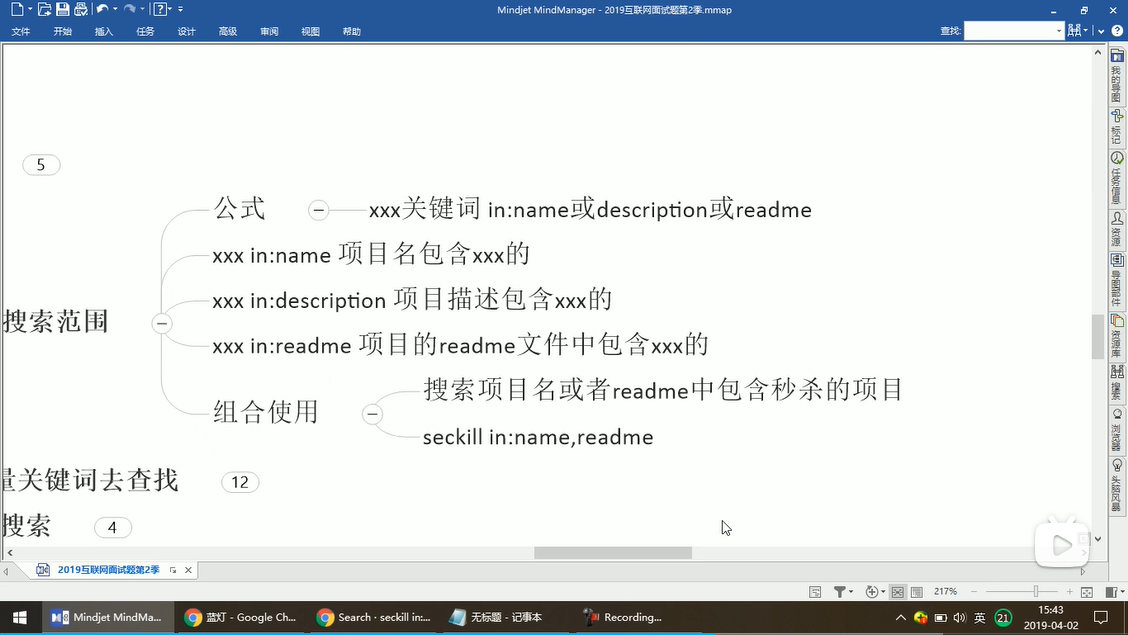并发与并行之间的区别? 并发相当于 多个线程来秒杀
你吃饭吃到一半,电话来了,你一直到吃完了以后才去接,这就说明你不支持并发也不支持并行。你吃饭吃到一半,电话来了,你停了下来接了电话,接完后继续吃饭,这说明你支持并发。你吃饭吃到一半,电话来了,你一边打电话一边吃饭,这说明你支持并行。并发的关键是你有处理多个任务的能力,不一定要同时。并行的关键是你有同时处理多个任务的能力。所以我认为它们最关键的点就是:是否是『同时』。
链接:https://www.zhihu.com/question/33515481/answer/58849148
https://www.zhihu.com/question/33515481
并发,指的是多个事情,在同一时间段内同时发生了。 并行,指的是多个事情,在同一时间点上同时发生了https://cloud.tencent.com/developer/article/1424249
并发: 并不是同时执行的, 是通过时间分片/快速切换, 给人一种同时执行的错觉
单核CPU只能并发, 不能并行
Lock 与 Synchronized 之间区别? Lock 是接口
Synchronized是自动锁, 在汇编采用 可以修饰非静态方法, 代码块, 一个对象, 一个类, 粒度比较大, 非公平锁需要 finally 块手动释放,否则易死锁
volatile 是什么? volatile 是 Java 虚拟机提供的轻量级的同步机制
画出JVM内存模型
JMM内存模型 JMM 可见性, 原子性, 有序性
本地内存就是工作内存
volatile 可见性实现 当 int number前面没有volatile关键字时, main线程会一直在while死循环中, myData.number的值没有得到及时更新
1 2 3 4 5 6 7 8 9 10 11 12 13 14 15 16 17 18 19 20 21 22 23 24 25 26 27 28 29 30 31 32 33 34 35 package com.atguigu.thread;import java.util.concurrent.TimeUnit;class MyData {volatile int number = 0 ;public void addTo60 () {this .number = 60 ;public class VolatileDemo {public static void main (String[] args) {MyData myData = new MyData ();new Thread (() -> {"\tcome in" );try {3 );catch (InterruptedException e) {"\t update number value: " + myData.number);"AAA" ).start();while (myData.number == 0 ) {"\t mission is over" );
存在volatile运行结果
1 2 3 AAA come inupdate number value : 60 is over
配置javap插件 参考: https://blog.csdn.net/stormkai/article/details/120079797
通过idea配置javap -c命令来配置下javap命令
1 2 3 Program:$ JDKPath$ \bin\javap.exe$ OutputPath$ \$ FileDirRelativeToSourcepath$ \$ FileNameWithoutAllExtensions$ .class$ ProjectFileDir$
volatile借助原子类AtomicInteger解决可见性 1 2 3 4 5 6 7 8 9 10 11 12 13 14 15 16 17 18 19 20 21 22 23 24 25 26 27 28 29 30 31 32 33 34 35 36 37 38 39 40 41 42 43 44 45 46 47 48 49 50 51 52 53 54 55 56 57 58 59 60 61 62 63 64 65 66 67 68 69 70 71 package com.atguigu.thread;import java.util.concurrent.TimeUnit;import java.util.concurrent.atomic.AtomicInteger;class MyData {volatile int number = 0 ;public void addTo60 () {this .number = 60 ;public void addPlusPlus () {AtomicInteger atomicInteger = new AtomicInteger ();public void addMyAtomic () {public class VolatileDemo {public static void main (String[] args) {MyData myData = new MyData ();for (int i = 1 ; i <= 20 ; i++) {new Thread (() -> {for (int j = 1 ; j <= 1000 ; j++) {while (Thread.activeCount() > 2 ) {yield ();"\t int type, finally number value: " + myData.number);"\t AtomicInteger type finally number value: " + myData.atomicInteger);private static void seeOKByVolatile () {MyData myData = new MyData ();new Thread (() -> {"\tcome in" );try {3 );catch (InterruptedException e) {"\t update number value: " + myData.number);"AAA" ).start();while (myData.number == 0 ) {"\t mission is over" );
指令重排 多线程环境中线程交替执行, 由于编译器优化重排的存在,
总结: 工作内存与主内存同步延迟现象导致的可见性问题
对于指令重排导致的可见性问题和有序性问题
单例模式-synchronized 1 2 3 4 5 6 7 8 9 10 11 12 13 14 15 16 17 18 19 20 21 22 23 24 25 26 27 28 29 30 31 32 33 34 35 package com.atguigu.thread;public class SingletonDemo {private static SingletonDemo instance;private SingletonDemo () {"\t构造方法SingletonDemo()" );public synchronized static SingletonDemo getInstance () {if (instance == null ) {new SingletonDemo ();return instance;public static void main (String[] args) {for (int i = 1 ; i <= 10 ; i++) {new Thread (() -> {
单例模式-volatile 1 2 3 4 5 6 7 8 9 10 11 12 13 14 15 16 17 18 19 20 21 22 23 24 25 26 27 28 29 30 31 32 33 34 35 36 37 38 39 40 package com.atguigu.thread;public class SingletonDemo {private volatile static SingletonDemo instance;private SingletonDemo () {"\t构造方法SingletonDemo()" );public static SingletonDemo getInstance () {if (instance == null ) {synchronized (SingletonDemo.class) {if (instance == null ) {new SingletonDemo ();return instance;public static void main (String[] args) {for (int i = 1 ; i <= 10 ; i++) {new Thread (() -> {
CAS 比较并交换
真实值与期望值相比较, 如果相同 , 修改值, 如果不同 , 不修改值
1 2 3 4 5 6 7 8 9 10 11 12 13 14 package com.atguigu.thread;import java.util.concurrent.atomic.AtomicInteger;public class CASDemo {public static void main (String[] args) {AtomicInteger atomicInteger = new AtomicInteger (5 );5 , 2019 ) + "\t current data: " + atomicInteger.get());5 , 1024 ) + "\t current data: " + atomicInteger.get());
atomicInteger底层源码 CAS 和 Unsafe类(Unsafe中的方法大部分都是native的)
1 2 3 4 5 6 7 8 9 10 11 12 13 14 15 atomicInteger.getAndIncrement()public final int getAndIncrement () {return unsafe.getAndAddInt(this , valueOffset, 1 );public final int getAndAddInt (Object var1, long var2, int var4) {int var5;do {this .getIntVolatile(var1, var2);while (!this .compareAndSwapInt(var1, var2, var5, var5 + var4));return var5;
CAS总结(CompareAndSwap):
CAS应用:
CAS缺点 循环时间长开销很大
ABA问题 CAS会导致”ABA问题”
比如说一个线程one从内存位置V中取出A,这时候另一个线程two也从内存中取出A,并且线程two进行了一些操作将值变成了B.
尽管线程one的CAS操作成功,但是不代表这个过程就是没有问题的。
原子引用 1 2 3 4 5 6 7 8 9 10 11 12 13 14 15 16 17 18 19 20 21 22 23 24 25 26 27 28 29 30 package com.atguigu.thread;import lombok.AllArgsConstructor;import lombok.Data;import lombok.NoArgsConstructor;import java.util.concurrent.atomic.AtomicReference;@Data @AllArgsConstructor @NoArgsConstructor class User {int age;public class AtomicReferenceDemo {public static void main (String[] args) {User z3 = new User ("z3" , 22 );User li4 = new User ("li4" , 25 );new AtomicReference <>();"\t" + atomicReference.get().toString());"\t" + atomicReference.get().toString());
如何解决ABA问题? 如何解决ABA问题, 使用版本号(时间戳stamp)
1 2 3 4 5 6 7 8 9 10 11 12 13 14 15 16 17 18 19 20 21 22 23 24 25 26 27 28 29 30 31 32 33 34 35 36 37 38 39 40 41 42 43 44 45 46 47 48 49 50 51 52 53 54 55 56 57 58 59 60 61 62 63 64 package com.atguigu.thread;import java.util.concurrent.TimeUnit;import java.util.concurrent.atomic.AtomicReference;import java.util.concurrent.atomic.AtomicStampedReference;public class ABADemo { static AtomicReference<Integer> atomicReference = new AtomicReference <>(100 );static AtomicStampedReference<Integer> atomicStampedReference = new AtomicStampedReference <>(100 , 1 );public static void main (String[] args) {"========== 以下是ABA问题的产生 ==========" );new Thread (() -> {100 , 101 );101 , 100 );"t1" ).start();new Thread (() -> {try {1 );catch (InterruptedException e) {100 , 2019 ) + "\t" + atomicReference.get());"t2" ).start();try {2 );catch (InterruptedException e) {"========== 以下是ABA问题的解决 ==========" );new Thread (() -> {int stamp = atomicStampedReference.getStamp();"\t" + "第 1 次版本号: " + stamp);try {1 );catch (InterruptedException e) {100 , 101 , stamp, atomicStampedReference.getStamp()+1 );"\t" + "第 2 次版本号: " + atomicStampedReference.getStamp());101 , 100 , atomicStampedReference.getStamp(), atomicStampedReference.getStamp()+1 );"\t" + "第 3 次版本号: " + atomicStampedReference.getStamp());"t3" ).start();new Thread (() -> {int stamp = atomicStampedReference.getStamp();"\t" + "第 1 次版本号: " + stamp);try {3 );catch (InterruptedException e) {boolean b = atomicStampedReference.compareAndSet(100 , 2024 , stamp, atomicStampedReference.getStamp() + 1 );"\t" + "修改成功否: " + b + "当前最新实际版本号: " + atomicStampedReference.getStamp());"\t" + "当前实际最新值: " + atomicStampedReference.getReference());"t4" ).start();
运行结果:
ArrayList容器不安全? 以及保证List安全 1 2 3 4 5 6 7 8 9 10 11 12 13 14 15 16 17 18 19 20 21 22 23 24 25 26 27 28 29 30 31 32 33 34 35 36 37 38 39 40 41 42 43 44 45 46 47 48 49 50 51 52 53 54 55 56 57 58 59 60 61 62 63 package com.atguigu.thread;import java.util.*;import java.util.concurrent.CopyOnWriteArrayList;public class ContainerNotSafeDemo {public static void main (String[] args) {new CopyOnWriteArrayList <>();for (int i = 1 ; i <= 30 ; i++) {new Thread (() -> {0 , 8 ));
拓展 set map
1 2 3 4 5 6 7 8 9 10 11 12 13 14 15 16 17 18 19 20 21 22 23 24 25 26 27 28 29 30 31 32 33 package com.atguigu.thread;import java.util.*;import java.util.concurrent.ConcurrentHashMap;import java.util.concurrent.CopyOnWriteArrayList;import java.util.concurrent.CopyOnWriteArraySet;public class ContainerNotSafeDemo {public static void main (String[] args) {new HashMap <>());for (int i = 1 ; i <= 30 ; i++) {new Thread (() -> {0 , 8 ));private static void setNotSafe () {new CopyOnWriteArraySet <>();for (int i = 1 ; i <= 30 ; i++) {new Thread (() -> {0 , 8 ));new HashSet <Integer>().add(1 );
一道传参练习题 1 2 3 4 5 6 7 8 9 10 11 12 13 14 15 16 17 18 19 20 21 22 23 24 25 26 27 28 29 30 31 32 33 34 35 36 37 38 39 40 41 42 43 44 45 46 package com.atguigu.thread;import lombok.Data;@Data class Person {private Integer id;private String personName;public Person (String personName) {this .personName = personName;public class TestTransferValue {public void changeValue1 (int age) {30 ;public void changeValue2 (Person person) {"xxx" );public void changeValue3 (String str) {"xxx" ;public static void main (String[] args) {TestTransferValue test = new TestTransferValue ();int age = 20 ;"age = " + age);Person person = new Person ("abc" );"person = " + person);String str = "abc" ;"str = " + str);
公平锁与非公平锁 公平锁 是指多个线程按照申请锁的顺序来获取锁,类似排队打饭,先来后到。
Java ReentrantLock而言
对于Synchronized而言, 也是一种非公平锁
可重入锁(又名递归锁) 可重入锁(又名递归锁)
指的是同一线程外层函数获得锁之后 ,内层递归函数仍然能获取该锁的代码,线程可以进入任何一个它已经拥有的锁所同步着的代码块。
锁中内部还有一把锁
ReentrantLock/Synchronized就是一个典型的可重入锁 可重入锁最大的作用就是避免死锁
java锁之可重入锁和递归锁代码验证
1 2 3 4 5 6 7 8 9 10 11 12 13 14 15 16 17 18 19 20 21 22 23 24 25 26 27 28 29 30 31 32 33 34 35 36 37 38 39 40 41 42 43 44 45 46 47 48 49 50 51 52 53 54 55 56 57 58 59 60 61 62 63 64 65 66 67 68 69 70 71 72 73 74 75 76 77 78 79 80 package com.atguigu.thread;import java.util.concurrent.TimeUnit;import java.util.concurrent.locks.Lock;import java.util.concurrent.locks.ReentrantLock;class Phone implements Runnable {public synchronized void sendSMS () {"\t sendSMS()" );public synchronized void sendEmail () {"\t sendEmail()" );@Override public void run () {Lock lock = new ReentrantLock ();private void get () {try {"\t get()" );finally {private void set () {try {"\t set()" );finally {public class ReenterLockDemo {public static void main (String[] args) {Phone phone = new Phone ();new Thread (() -> {"t1" ).start();new Thread (() -> {"t2" ).start();try {2 );catch (InterruptedException e) {Thread t3 = new Thread (phone, "t3" );Thread t4 = new Thread (phone, "t4" );
自旋锁 (spinlock) 是指尝试获取锁的线程不会立即阳塞,而是采用循环的方式去尝试获取锁,这样的好处是减少线程上下文切换的消耗,缺
手写自旋锁
1 2 3 4 5 6 7 8 9 10 11 12 13 14 15 16 17 18 19 20 21 22 23 24 25 26 27 28 29 30 31 32 33 34 35 36 37 38 39 40 41 42 43 44 45 46 47 48 49 50 51 52 53 package com.atguigu.thread;import java.util.concurrent.TimeUnit;import java.util.concurrent.atomic.AtomicReference;public class SpinLockDemo {new AtomicReference <>();public void myLock () {Thread thread = Thread.currentThread();"\t myLock" );while (!atomicReference.compareAndSet(null , thread)) {public void myUnLock () {Thread thread = Thread.currentThread();"\t myUnLock" );null );public static void main (String[] args) {SpinLockDemo spinLockDemo = new SpinLockDemo ();new Thread (() -> {try {5 );catch (InterruptedException e) {throw new RuntimeException (e);"t1" ).start();try {2 );catch (InterruptedException e) {throw new RuntimeException (e);new Thread (() -> {try {2 );catch (InterruptedException e) {throw new RuntimeException (e);"t2" ).start();
读写锁 独占锁: 指该锁一次只能被一个线程所持有。对ReentrantLock和Synchronized而言都是独占锁
未使用读写锁暴露出来的问题
1 2 3 4 5 6 7 8 9 10 11 12 13 14 15 16 17 18 19 20 21 22 23 24 25 26 27 28 29 30 31 32 33 34 35 36 37 38 39 40 41 42 43 44 45 46 47 48 49 50 51 52 53 54 55 56 57 58 59 60 61 62 63 64 65 66 67 68 69 70 71 72 73 74 package com.atguigu.thread;import java.util.HashMap;import java.util.Map;class MyCache {private volatile Map<String, Object> map = new HashMap <>();public void put (String key, Object value) {"\t 正在写入: " + key);"\t 写入完成" );public void get (String key) {"\t 正在读取" );Object result = map.get(key);"\t 读取完成: " + result);public void clear () {public class ReadWriteLockDemo {public static void main (String[] args) {MyCache mycache = new MyCache ();for (int i = 1 ; i <= 5 ; i++) {final int finalInt = i;new Thread (() -> {"" , finalInt + "" );for (int i = 1 ; i <= 5 ; i++) {final int finalInt = i;new Thread (() -> {"" );
CountDownLatch 让一些线程阻塞直到另一些线程完成一系列操作后才被唤醒
1 2 3 4 5 6 7 8 9 10 11 12 13 14 15 16 17 18 19 20 21 22 23 24 25 26 27 28 29 30 31 32 33 34 35 36 37 38 39 40 41 42 43 44 45 46 47 48 49 50 51 52 53 54 55 56 57 58 59 60 61 62 63 64 65 66 67 68 69 70 71 72 73 74 75 76 77 78 79 80 81 82 83 84 85 86 87 88 89 90 91 92 93 94 95 96 97 98 99 100 package com.atguigu.thread;import lombok.Getter;import java.util.concurrent.CountDownLatch;enum CountryEnum {1 , "齐" ), TWO(2 , "楚" ), THREE(3 , "燕" ), FOUR(4 , "赵" ), FIVE(5 , "魏" ), SIX(6 , "韩" );@Getter private Integer retCode;@Getter private String retMessage;this .retCode = retCode;this .retMessage = retMessage;public static CountryEnum forEach_CountryEnum (int index) {for (CountryEnum value : CountryEnum.values()) {if (value.getRetCode() == index) {return value;return null ;public class CountDownLatchDemo {public static void main (String[] args) throws InterruptedException {CountDownLatch countDownLatch = new CountDownLatch (6 );for (int i = 1 ; i <= 6 ; i++) {new Thread (() -> {"国, 被灭" );"秦帝国, 一统华夏" );private static void closeDoor () throws InterruptedException {CountDownLatch countDownLatch = new CountDownLatch (6 );for (int i = 1 ; i <= 6 ; i++) {new Thread (() -> {"\t上完晚自习, 离开教室" );"班长最后关门走人" );
CyclicBarrier CyclicBarrier Cyclic循环 Barrier屏障
CyclicBarrier的字面意思是可循环 (Cyclic) 使用的屏障 (Barrier)。
集齐7颗龙珠就能召唤神龙
1 2 3 4 5 6 7 8 9 10 11 12 13 14 15 16 17 18 19 20 21 22 23 24 25 26 27 28 29 30 31 32 33 34 35 36 package com.atguigu.thread;import java.util.concurrent.BrokenBarrierException;import java.util.concurrent.CyclicBarrier;public class CyclicBarrierDemo {public static void main (String[] args) {CyclicBarrier cyclicBarrier = new CyclicBarrier (7 , () -> {"召唤神龙" );for (int i = 1 ; i <= 7 ; i++) {new Thread (() -> {"收集到第:" + Thread.currentThread().getName() + "\t龙珠" );try {catch (InterruptedException e) {throw new RuntimeException (e);catch (BrokenBarrierException e) {throw new RuntimeException (e);
Semaphore Semaphore 信号量 , 信号灯
信号量主要用于两个目的, 一个是用于多个共享资源的互斥使用, 另一个用于并发线程数的控制
1 2 3 4 5 6 7 8 9 10 11 12 13 14 15 16 17 18 19 20 21 22 23 24 25 26 27 28 29 30 31 32 33 34 35 36 37 38 39 40 41 42 43 44 45 package com.atguigu.thread;import java.util.concurrent.Semaphore;import java.util.concurrent.TimeUnit;public class SemaphoreDemo {public static void main (String[] args) {Semaphore semaphore = new Semaphore (3 ); for (int i = 1 ; i <= 6 ; i++) { new Thread (() -> {try {"\t抢到车位" );try {3 );catch (InterruptedException e) {throw new RuntimeException (e);"\t停车3秒后离开车位" );catch (InterruptedException e) {throw new RuntimeException (e);finally {
BlockQueue 阻塞队列
*试图从空的阻塞队列中获取元素的线程将会被阻塞,直到其他的线程往空的队列插入新的元素。
在多线程领域: 所谓阻塞,在某些情况下会挂起线程(即阻塞),一旦条件满足,被挂起的线程又会自动被唤醒
为什么需要BlockingQueue
在concurrent包发布以前,在多线程环境下,我们每个程序员都必须去自己控制这些细节,尤其还要兼顾效率和线程安全,而这会给我们的程序带来不小的复杂度。
1 2 3 4 5 6 7 8 9 10 11 12 13 14 15 16 17 18 19 20 21 22 23 24 25 26 27 28 29 30 31 32 33 34 35 36 37 38 39 40 41 42 43 44 45 46 47 48 49 50 51 52 53 54 55 56 57 58 59 60 61 62 63 64 65 66 67 68 69 70 71 72 package com.atguigu.thread;import java.util.ArrayList;import java.util.List;import java.util.concurrent.ArrayBlockingQueue;import java.util.concurrent.BlockingQueue;import java.util.concurrent.TimeUnit;public class BlockingQueueDemo {public static void main (String[] args) throws InterruptedException {new ArrayBlockingQueue <>(3 );"a" , 2L , TimeUnit.SECONDS));"a" , 2L , TimeUnit.SECONDS));"a" , 2L , TimeUnit.SECONDS));
SynchronousQueue 阻塞队列之同步SynchronousQueue队列
SynchronousQueue没有容量
synchronousQueue 生产一个阻塞等待消费一个, 并不会存储第二个, 只有第一个消费掉了, 才会开始生产第二个
1 2 3 4 5 6 7 8 9 10 11 12 13 14 15 16 17 18 19 20 21 22 23 24 25 26 27 28 29 30 31 32 33 34 35 36 37 38 39 40 41 42 43 44 45 46 47 48 49 50 51 package com.atguigu.thread;import java.util.concurrent.SynchronousQueue;import java.util.concurrent.TimeUnit;public class SynchronousQueueDemo {public static void main (String[] args) {new SynchronousQueue <>();new Thread (() -> {try {"\t put 1" );"1" );"\t put 2" );"2" );"\t put 3" );"3" );catch (InterruptedException e) {throw new RuntimeException (e);"AAA" ).start();new Thread (() -> {try {5 );"\t get" + synchronousQueue.take());5 );"\t get" + synchronousQueue.take());5 );"\t get" + synchronousQueue.take());catch (InterruptedException e) {throw new RuntimeException (e);"BBB" ).start();
线程通信之生产者消费者传统版 1 2 3 4 5 6 7 8 9 10 11 12 13 14 15 16 17 18 19 20 21 22 23 24 25 26 27 28 29 30 31 32 33 34 35 36 37 38 39 40 41 42 43 44 45 46 47 48 49 50 51 52 53 54 55 56 57 58 59 60 61 62 63 64 65 66 67 68 69 70 71 72 73 74 75 76 77 78 79 80 81 82 83 84 85 86 87 88 89 90 91 92 93 94 95 96 97 98 99 package com.atguigu.thread;import java.util.concurrent.locks.Condition;import java.util.concurrent.locks.Lock;import java.util.concurrent.locks.ReentrantLock;class ShareData {private int number = 0 ;private Lock lock = new ReentrantLock ();private Condition condition = lock.newCondition();public void increment () throws Exception {try {while (number != 0 ) {"\t" + number);finally {public void decrement () throws Exception {try {while (number == 0 ) {"\t" + number);finally {public class ProdConsumer_TraditionDemo {public static void main (String[] args) {ShareData shareData = new ShareData ();new Thread (() -> {for (int i = 1 ; i <= 5 ; i++) {try {catch (Exception e) {throw new RuntimeException (e);"AA" ).start();new Thread (() -> {for (int i = 1 ; i <= 5 ; i++) {try {catch (Exception e) {throw new RuntimeException (e);"BB" ).start();
wait方法是什么类的? Object
Synchronized和Lock有什么区别 1 2 3 4 5 6 7 8 9 10 11 12 13 14 15 16 17 18 19 20 21 22 23 24 25 26 27 28 29 30 31 32 33 34 35 36 37 38 39 40 41 42 43 44 45 46 47 48 49 50 51 52 package com.atguigu.thread;import java.util.concurrent.locks.Lock;import java.util.concurrent.locks.ReentrantLock;public class SyncAndReentrantLockDemo {public static void main (String[] args) {synchronized (new Object ()) {Lock lock = new ReentrantLock ();
锁绑定多个条件Condition 1 2 3 4 5 6 7 8 9 10 11 12 13 14 15 16 17 18 19 20 21 22 23 24 25 26 27 28 29 30 31 32 33 34 35 36 37 38 39 40 41 42 43 44 45 46 47 48 49 50 51 52 53 54 55 56 57 58 59 60 61 62 63 64 65 66 67 68 69 70 71 72 73 74 75 76 77 78 79 80 81 82 83 84 85 86 87 88 89 90 91 92 93 94 95 96 97 98 99 100 101 102 103 104 105 106 107 108 109 110 111 112 113 114 115 116 117 118 119 120 121 122 123 124 125 126 127 128 129 130 131 132 133 134 package com.atguigu.thread;import java.util.concurrent.locks.Lock;import java.util.concurrent.locks.ReentrantLock;class ShareResource {private int number = 1 ;private Lock lock = new ReentrantLock ();Condition c1 = lock.newCondition();Condition c2 = lock.newCondition();Condition c3 = lock.newCondition();public void print5 () {try {while (number != 1 ) {try {catch (InterruptedException e) {throw new RuntimeException (e);for (int i = 1 ; i <= 5 ; i++) {"\t" + i);2 ;finally {public void print10 () {try {while (number != 2 ) {try {catch (InterruptedException e) {throw new RuntimeException (e);for (int i = 1 ; i <= 10 ; i++) {"\t" + i);3 ;finally {public void print15 () {try {while (number != 3 ) {try {catch (InterruptedException e) {throw new RuntimeException (e);for (int i = 1 ; i <= 15 ; i++) {"\t" + i);1 ;finally {public class SyncAndReentrantLockDemo {public static void main (String[] args) {ShareResource shareResource = new ShareResource ();new Thread (() -> {for (int i = 1 ; i <= 10 ; i++) {"A" ).start();new Thread (() -> {for (int i = 1 ; i <= 10 ; i++) {"B" ).start();new Thread (() -> {for (int i = 1 ; i <= 10 ; i++) {"C" ).start();
线程通信之生产者消费者阻塞队列版 1 2 3 4 5 6 7 8 9 10 11 12 13 14 15 16 17 18 19 20 21 22 23 24 25 26 27 28 29 30 31 32 33 34 35 36 37 38 39 40 41 42 43 44 45 46 47 48 49 50 51 52 53 54 55 56 57 58 59 60 61 62 63 64 65 66 67 68 69 70 71 72 73 74 75 76 77 78 79 80 81 82 83 84 85 86 87 88 89 90 91 92 package com.atguigu.thread;import java.util.concurrent.ArrayBlockingQueue;import java.util.concurrent.BlockingQueue;import java.util.concurrent.TimeUnit;import java.util.concurrent.atomic.AtomicInteger;class MyResource {private volatile boolean FLAG = true ; private AtomicInteger atomicInteger = new AtomicInteger ();null ;public MyResource (BlockingQueue<String> blockingQueue) {this .blockingQueue = blockingQueue;public void myProd () throws Exception {String data = null ;boolean retValue;while (FLAG) {"" ;2L , TimeUnit.SECONDS);if (retValue) {"\t插入队列" + data + "成功" );else {"\t插入队列" + data + "失败" );1 );"\t大老板叫停了, 表示FLAG = false, 生产动作结束" );public void myConsumer () throws Exception {String result = null ;while (FLAG) {2L , TimeUnit.SECONDS);if (null == result || result.equalsIgnoreCase("" )) {false ;"\t超过2秒钟没有取到蛋糕, 消费退出" );return ;"\t消费队列蛋糕" + result + "成功" );public void stop () {this .FLAG = false ;public class ProdConsumer_BlockQueueDemo {public static void main (String[] args) {MyResource myResource = new MyResource (new LinkedBlockingQueue <>(10 )); "\t生产线程启动" );try {catch (Exception e) {throw new RuntimeException (e);"Prod" ).start();new Thread (() -> {"\t消费线程启动" );try {catch (Exception e) {throw new RuntimeException (e);"Consumer" ).start();try {5 );catch (InterruptedException e) {throw new RuntimeException (e);"5秒钟时间到, 大老板main线程叫停, 活动结束" );
线程池 线程池使用及优势 为什么用线程池,优势
线程池做的工作主要是控制运行的线程的数量,处理过程中将任务放入队列,然后在线程创建后启动这些任务,如果线程数量超过了最大数量超出数量的线程排队等候,等其它线程执行完毕,再从队列中取出任务来执行。
他的主要特点为:线程复用,控制最大并发数;管理线程
第一:降低资源消耗。通过重复利用已创建的线程降低线程创建和销毁造成的消耗。
1 2 3 4 5 6 7 8 9 package com.atguigu.thread;public class MyThreadPoolDemo {public static void main (String[] args) {
Java中线程池是通过Executor框架实现的, 该框架中用到了 Executor , Executors, ExecutorService, ThreadPoolExecutor这几个类
常用的几个创建线程池的方法
1 2 3 4 5 6 7 int parallelism);
线程池3个常用方式 1 2 3 4 5 6 7 8 9 10 11 12 13 14 15 16 17 18 19 20 21 22 23 24 25 26 27 28 29 30 31 32 33 34 35 36 37 38 39 40 41 42 43 44 45 46 47 48 49 50 51 52 53 54 55 56 57 58 59 60 61 62 63 package com.atguigu.thread;import java.util.concurrent.Executor;import java.util.concurrent.ExecutorService;import java.util.concurrent.Executors;import java.util.concurrent.TimeUnit;public class MyThreadPoolDemo {public static void main (String[] args) {ExecutorService threadPool = Executors.newCachedThreadPool(); try {for (int i = 1 ; i <= 10 ; i++) {"\t 办理业务" );finally {
Executors.newFixedThreadPool(5); 执行长期任务, 性能好很多
以上三个方法的底层实现其实都是通过返回 ThreadPoolExecutor 对象实现的
创建线程的有哪几种方式? 创建线程的有哪几种方式?
线程池的几个重要参数介绍? 通过观察源码发现, 最终返回的都是 ThreadPoolExecutor() 方法
1 2 3 4 5 6 7 8 public ThreadPoolExecutor (int corePoolSize, int maximumPoolSize, long keepAliveTime, TimeUnit unit, BlockingQueue<Runnable> workQueue) {this (corePoolSize, maximumPoolSize, keepAliveTime, unit, workQueue,
发现 ThreadPoolExecutor 接收参数之后调用了 this, this构造方法如下:
1 2 3 4 5 6 7 8 9 10 11 12 13 14 15 16 17 18 19 20 21 22 23 24 public ThreadPoolExecutor (int corePoolSize, int maximumPoolSize, long keepAliveTime, TimeUnit unit, BlockingQueue<Runnable> workQueue, ThreadFactory threadFactory, RejectedExecutionHandler handler) {if (corePoolSize < 0 ||0 ||0 )throw new IllegalArgumentException ();if (workQueue == null || threadFactory == null || handler == null )throw new NullPointerException ();this .acc = System.getSecurityManager() == null ?null :this .corePoolSize = corePoolSize;this .maximumPoolSize = maximumPoolSize;this .workQueue = workQueue;this .keepAliveTime = unit.toNanos(keepAliveTime);this .threadFactory = threadFactory;this .handler = handler;
总共七个参数, 如下
说说线程池的底层工作原理?
线程池的4种拒绝策略你谈谈 是什么?
AbortPolicy(默认): 直接抛出 RejectedExecutionException 异常阻止系统正常运行
以上内置拒绝策略均实现了RejectedExecutionHandler接口
你在工作中单一的/固定数的/可变的三种创建线程池的方法, 你用的哪个多? 超级大坑 你在工作中单一的/固定数的/可变的三种创建线程池的方法, 你用的哪个多? 超级大坑
通过观察底层源码
1 2 3 4 5 6 7 8 9 10 11 12 13 14 15 16 17 18 19 20 21 22 23 24 25 26 27 public static ExecutorService newFixedThreadPool (int nThreads, ThreadFactory threadFactory) {return new ThreadPoolExecutor (nThreads, nThreads,0L , TimeUnit.MILLISECONDS,new LinkedBlockingQueue <Runnable>(),public static ExecutorService newSingleThreadExecutor () {return new FinalizableDelegatedExecutorService new ThreadPoolExecutor (1 , 1 ,0L , TimeUnit.MILLISECONDS,new LinkedBlockingQueue <Runnable>()));public LinkedBlockingQueue () {this (Integer.MAX_VALUE);public static ExecutorService newCachedThreadPool () {return new ThreadPoolExecutor (0 , Integer.MAX_VALUE,60L , TimeUnit.SECONDS,new SynchronousQueue <Runnable>());
使用 Executors 创建出来的线程池, 都是无界的队列, 这可能会非常消耗资源
并且, 在阿里巴巴手册提及到
【强制】线程资源必须通过线程池提供,不允许在应用中自行显式创建线程。
【强制】线程池不允许使用 Executors 去创建,而是通过 ThreadPoolExecutor 的方式,这
你在工作中是如何使用线程池的, 是否自定义过线程池使用? 使用 new ThreadPoolExecutor() 自定义线程池
1 2 3 4 5 6 7 8 9 10 11 12 13 14 15 16 17 18 19 20 21 22 23 24 25 26 27 28 29 30 31 32 33 34 35 36 37 38 39 40 41 42 43 44 45 46 47 48 49 50 51 52 53 54 55 56 57 58 59 60 61 62 63 64 65 package com.atguigu.thread;import java.util.concurrent.*;public class MyThreadPoolDemo {public static void main (String[] args) {ExecutorService threadPool = new ThreadPoolExecutor (3 ,5 ,1L ,new LinkedBlockingQueue <Runnable>(3 ),new ThreadPoolExecutor .DiscardPolicy() try {for (int i = 1 ; i <= 10 ; i++) {"\t 办理业务" );finally {private static void threadPoolInit () {ExecutorService threadPool = Executors.newCachedThreadPool(); try {for (int i = 1 ; i <= 10 ; i++) {"\t 办理业务" );finally {
合理配置线程池你是如何考虑的? CPU密集型:
死锁编码及定位分析 什么是死锁?
死锁产生的主要原因:
死锁demo
1 2 3 4 5 6 7 8 9 10 11 12 13 14 15 16 17 18 19 20 21 22 23 24 25 26 27 28 29 30 31 32 33 34 35 36 37 38 39 40 41 42 43 44 45 46 47 48 49 50 51 package com.atguigu.thread;import java.util.concurrent.TimeUnit;class HoldLockThread implements Runnable {private String lockA;private String lockB;public HoldLockThread (String lockA, String lockB) {this .lockA = lockA;this .lockB = lockB;@Override public void run () {synchronized (lockA) {"\t 自己持有: " + lockA + "\t 尝试获得: " + lockB);try {2 );catch (InterruptedException e) {throw new RuntimeException (e);synchronized (lockB) {"\t 自己持有: " + lockB + "\t 尝试获得: " + lockA);public class DeadLockDemo {public static void main (String[] args) {String lockA = "lockA" ;String lockB = "lockB" ;new Thread (new HoldLockThread (lockA, lockB), "AAA" ).start();new Thread (new HoldLockThread (lockB, lockA), "BBB" ).start();
如何排查死锁?
1 2 3 4 5 6 7 8 9 10 11 12 13 14 15 16 17 18 19 20 21 22 23 24 25 26 27 28 29 30 31 32 33 34 35 36 37 38 39 40 41 42 43 44 45 46 47 48 49 50 51 52 53 54 55 56 57 58 59 60 61 62 63 64 65 66 67 68 69 70 71 72 73 74 75 76 77 78 79 80 81 82 83 84 85 86 87 88 89 90 91 92 93 94 95 96 97 98 99 100 101 102 103 104 105 106 107 108 109 110 111 112 113 114 115 116 117 118 119 120 121 122 123 $ jps -l "DestroyJavaVM" "BBB" "AAA" "Service Thread" "C1 CompilerThread3" "C2 CompilerThread2" "C2 CompilerThread1" "C2 CompilerThread0" "Monitor Ctrl-Break" read (SocketInputStream.java:171)read (SocketInputStream.java:141)read (StreamDecoder.java:178)read (InputStreamReader.java:184)$1 .run(AppMainV2.java:53)"Attach Listener" "Signal Dispatcher" "Finalizer" wait (Native Method)$Lock )$Lock )$FinalizerThread .run(Finalizer.java:209)"Reference Handler" wait (Native Method)$Lock )wait (Object.java:502)$Lock )$ReferenceHandler .run(Reference.java:153)"VM Thread" os_prio=2 tid=0x000000001c3a9800 nid=0x1694 runnable"GC task thread#0 (ParallelGC)" os_prio=0 tid=0x0000000002938000 nid=0x6590 runnable"GC task thread#1 (ParallelGC)" os_prio=0 tid=0x0000000002939800 nid=0x24dc runnable"GC task thread#2 (ParallelGC)" os_prio=0 tid=0x000000000293b000 nid=0x5930 runnable"GC task thread#3 (ParallelGC)" os_prio=0 tid=0x000000000293c800 nid=0x5d98 runnable"GC task thread#4 (ParallelGC)" os_prio=0 tid=0x000000000293f000 nid=0x4390 runnable"GC task thread#5 (ParallelGC)" os_prio=0 tid=0x0000000002941000 nid=0x7950 runnable"BBB" :which is held by "AAA" "AAA" :which is held by "BBB" for the threads listed above:"BBB" :"AAA" :
常见的垃圾回收算法 0.JVM体系结构概述
1.引用计数
2.复制
3.标记清除
4.标记整理
JVM复习题 1.JVM垃圾回收的时候如何确定垃圾?是否知道什么是GC Roots 1.什么是垃圾?
2.要进行垃圾回收, 如何判断一个对象是否可以被回收?
a)case
b)Java中可以作为CG Roots的对象
Person p1 = new Person();
2.你说你做过JVM调优和参数配置,请问如何盘点查看JVM系统默认值
JVM的参数类型
(2) X参数(了解)
(3) XX参数+或者 -某个属性值
如何查看一个正在运行中的Java程序, 它的某个jvm参数是否开启? 具体指是多少?
编写如下代码:
1 2 3 4 5 6 7 8 9 package com.atguigu.thread;public class HelloGC {public static void main (String[] args) throws InterruptedException {"HelloGC" );
输入如下命令进行查看正在运行的java程序是否开启了某个jvm参数
1 2 $ jps -l
在VM Options中添加参数 -XX:+PrintGCDetails , 再次查看此时运行的jvm参数, 变成了 +, 之前默认是 -
(3.2) KV设值类型
1 2 3 $ jps -l
查看默认的 元空间大小 21807104 / 1024 / 1024 ≈ 21M
修改元空间大小, 设置VM options : -XX:MetaspaceSize=128m
同理可以查看 MaxTenuringThreshold 设置对象进入老年代的最大年龄阈值
(4) jinfo举例, 如何查看当前运行程序的配置jinfo -flag 配置项进程编号
1 2 3 jps
(5) 题外话(坑题)
判断家底查看JVM默认值java -XX:+PrintFlagsInitial -versionjava -XX:+PrintFlagsInitial
(2) -XX:+PrintFlagsFinaljava -XX:+PrintFlagsFinal -versionjava -XX:+PrintFlagsFinal -version
:= 说明被人为的修改过了, =表示是默认值
(3) PrintFlagsFinal 举例, 运行java命令的同时打印参数
1 2 3 4 5 6 7 8 9 10 11 package com.atguigu.thread;public class T {public static void main (String[] args) {int a = 100 ;int b = 200 ;int retValue = a + b;"retValue = " + retValue);
编译运行
1 2 3 4 5 6 7 8 9 10 11 12 13 14 15 16 17 18 19 20 21 22 23 24 25 26 27 28 29 30 31 32 PS E:\Code\面试题\大厂面试题第2季\src\main\java\com\atguigu\thread> pwd "retValue = " + retValue);ls cd ../../../cp . com.atguigu.thread.T
运行java命令的同时打印参数, 可以观察到 , 可以通过自己手动指定参数将参数的默认值进行修改
1 2 3 4 5 6 7 8 9 PS E:\Code\面试题\大厂面试题第2季\src\main\java> java -XX:+PrintFlagsFinal com.atguigu.thread.T
(4) -XX:+PrintCommandLineFlags
1 2 3 4 5 6 $ java -XX:+PrintCommandLineFlags -version"1.8.0_141"
3.你平时工作用过的JVM常用基本配置参数有哪些? 1.基础知识复习
1 2 3 4 5 6 7 8 9 10 11 12 13 14 15 16 package com.atguigu.thread;public class HelloGC {public static void main (String[] args) throws InterruptedException {long totalMemory = Runtime.getRuntime().totalMemory(); long maxMemory = Runtime.getRuntime().maxMemory(); "TOTAL_MEMORY(-Xms) = " + totalMemory + "(字节)、" + (totalMemory / (double ) 1024 / 1024 ) + "MB" );"MAX_MEMORY(-Xmx) = " + maxMemory + "(字节)、" + (maxMemory / (double ) 1024 / 1024 ) + "MB" );
2.常用参数 -Xms: 初始大小内存, 默认为物理内存1/64-XX:InitialHeapSize
-Xmx 初始大小内存, 默认为物理内存1/4-XX:MaxHeapSize
-Xss 设置单个线程栈的大小, 一般默认为512k~1024k-XX:ThreadStackSize
1 2 3 4 5 6 7 8 9 10 11 12 13 14 15 16 17 18 19 20 21 22 23 24 25 26 27 28 29 30 31 32 33 34 35 36 37 38 39 40 $ cat .\HelloGC.java"HelloGC" );sleep (Integer.MAX_VALUE);cd ../../..
-XX:ThreadStackSize=0 并不是说明栈空间大小是0, 而是表明使用平台默认值
-Xmn -Xmn: 设置年轻代大小
设置元空间大小: 元空间的本质和永久代类似,都是对JVM规范中方法区的实现。
1 -Xms10m -Xmx10m -XX:MetaspaceSize=1024m -XX:PrintFlagsFinal
添加参数 -XX:+PrintFlagsFinal 查看
1 uintx MetaspaceSize = 21807104 {pd product}
jdk中默认的元空间的大小是 21807104
典型设置案例 添加参数查看 -XX:+PrintCommandLineFlags
1 2 -XX:InitialHeapSize=265625408 -XX:MaxHeapSize=4250006528 -XX:+PrintCommandLineFlags -XX:+UseCompressedClassPointers -XX:+UseCompressedOops -XX:-UseLargePagesIndividualAllocation -XX:+UseParallelGC
修改参数
1 -Xms128m -Xmx4096m -Xss1024k -XX:MetaspaceSize=512m -XX:+PrintCommandLineFlags -XX:+PrintGCDetails -XX:+UseSerialGC
运行得到
1 -XX:InitialHeapSize=134217728 -XX:MaxHeapSize=4294967296 -XX:MetaspaceSize=536870912 -XX:+PrintCommandLineFlags -XX:+PrintGCDetails -XX:ThreadStackSize=1024 -XX:+UseCompressedClassPointers -XX:+UseCompressedOops -XX:-UseLargePagesIndividualAllocation -XX:+UseSerialGC
-XX:+PrintGCDetails 输出详细GC收集日志信息: -XX:+PrintGCDetails
1 2 3 4 5 6 7 8 9 package com.atguigu.thread;public class HelloGC {public static void main (String[] args) throws InterruptedException {"HelloGC" );byte [] bytes = new byte [50 * 1024 * 1024 ];
vm Options中添加参数
运行结果
1 2 3 4 5 6 7 8 9 10 HelloGC
修改参数
1 -Xms10m -Xmx10m -XX:+PrintGCDetails
运行结果
1 2 3 4 5 6 7 8 9 10 11 12 13 14 15 16 17 HelloGCin thread "main" java.lang.OutOfMemoryError: Java heap space
GC
FullGC
-XX:SurvivorRatio
设置新生代中eden和S0/S1空间的比例-XX:SurvivorRatio=8 Eden:S0:S1 = 8:1:1-XX:SurvivorRatio=4 Eden:S0:S1 = 4:1:1
代码
1 2 3 4 5 6 7 8 package com.atguigu.thread;public class HelloGC {public static void main (String[] args) throws InterruptedException {"HelloGC" );
添加参数
1 -XX:+PrintGCDetails -XX:+UseSerialGC -Xms10m -Xmx10m
或者添加参数, 只是省略了 SurvivorRatio 的配置, 默认 SurvivorRatio 就是8
1 2 -XX:+PrintGCDetails -XX:+UseSerialGC -Xms10m -Xmx10m -XX:SurvivorRatio=8
运行结果:
1 2 3 4 5 6 7 8 9 10 HelloGC
修改参数
1 -XX:+PrintGCDetails -XX:+UseSerialGC -Xms10m -Xmx10m -XX:SurvivorRatio=4
运行结果:
1 2 3 4 5 6 7 8 9 10 HelloGC
-XX:NewRatio 配置年轻代与老年代在堆结构的占比
参数:
1 2 3 4
运行结果:
1 2 3 4 5 6 7 8 9 10 11 12 13 14 15 16 17 18 19 20 21 22 23 HelloGC
-XX:MaxTenuringThreshold 设置垃圾最大年龄
1 2 3 4 5 6 7 8 package com.atguigu.thread;public class HelloGC {public static void main (String[] args) throws InterruptedException {"HelloGC" );
老年代年龄默认是15
添加参数
1 -XX:MaxTenuringThreshold=12
值得注意的是 MaxTenuringThreshold 的取值范围是: 0~15
1 2 3 Error: Could not create the Java Virtual Machine.exit .
运行结果:
1 2 3 4 5 6 7 8 9 10 11 $ jps -l
4.强引用、软引用、弱引用、虚引用分别是什么? 整体架构:
强引用(默认支持模式)
obj2 强引用, 不会被垃圾回收
1 2 3 4 5 6 7 8 9 10 11 12 package com.atguigu.jvm;public class StrongReferenceDemo {public static void main (String[] args) {Object obj1 = new Object (); Object obj2 = obj1; null ;
软引用 SoftReference 当系统内存充足时它不会被回收
1 2 3 4 5 6 7 8 9 10 11 12 13 14 15 16 17 18 19 20 21 22 23 24 25 26 27 28 29 30 31 32 33 34 35 36 37 38 39 40 41 42 43 44 45 46 47 48 49 50 51 52 package com.atguigu.jvm;import java.lang.ref.SoftReference;public class SoftReferenceDemo {public static void softRef_Memory_Enough () {Object o1 = new Object ();new SoftReference <>(o1);null ;public static void softRef_Memory_NotEnough () {Object o1 = new Object ();new SoftReference <>(o1);null ;try {byte [] bytes = new byte [30 * 1024 * 1024 ];catch (Exception e) {throw new RuntimeException (e);finally {public static void main (String[] args) {
弱引用 WeakReference case 不管内存够不够用, 最终都会回收该对象
1 2 3 4 5 6 7 8 9 10 11 12 13 14 15 16 17 18 19 package com.atguigu.jvm;import java.lang.ref.WeakReference;public class WeakReferenceDemo {public static void main (String[] args) {Object o1 = new Object ();new WeakReference <>(o1);null ;
软引用和弱引用的适用场景
你知道弱引用的话, 能谈谈WeakHashMap吗?
WeakHashMap继承AbstractMap,实现了Map接口。和HashMap一样,WeakHashMap也是一个散列表,它存储的内容也是键值对(key-value)映射,而且键和值都可以是null。在WeakHashMap中,当某个键不再正常使用时,会被从WeakHashMap中被自动移除 。更精确地说,对于一个给定的键,其映射的存在并不阻止垃圾回收器对该键的丢弃,这就使该键成为可终止的,被终止,然后被回收。某个键被终止时,它对应的键值对也就从映射中有效地移除了。https://blog.csdn.net/u014294681/article/details/86522487
在WeakHashMap中,当某个键不再正常使用时,会被从WeakHashMap中被自动移除
1 2 3 4 5 6 7 8 9 10 11 12 13 14 15 16 17 18 19 20 21 22 23 24 25 26 27 28 29 30 31 32 33 34 35 36 37 38 39 40 41 42 43 44 package com.atguigu.jvm;import java.util.HashMap;import java.util.WeakHashMap;public class WeakHashDemo {public static void main (String[] args) {private static void myHashMap () {new HashMap <>();Integer key = new Integer (1 );String value = "HashMap" ;null ;private static void myWeakHashMap () {new WeakHashMap <>();Integer key = new Integer (2 );String value = "WeakHashMap" ;null ;
虚引用 PhantomReference 虚引用
引用队列
引用队列case 虚引用在垃圾回收之后, 会被放到引用队列中进行保存
1 2 3 4 5 6 7 8 9 10 11 12 13 14 15 16 17 18 19 20 21 22 23 24 25 26 27 28 29 30 31 32 33 34 35 36 37 38 39 package com.atguigu.jvm;import java.lang.ref.ReferenceQueue;import java.lang.ref.WeakReference;public class ReferenceQueueDemo {public static void main (String[] args) throws InterruptedException {Object o1 = new Object ();new ReferenceQueue <>();new WeakReference <>(o1, referenceQueue);null ;500 );
虚引用case 1 2 3 4 5 6 7 8 9 10 11 12 13 14 15 16 17 18 19 20 21 22 23 24 25 26 27 28 29 30 31 32 33 34 35 36 37 38 39 40 41 42 43 44 45 46 47 48 49 package com.atguigu.jvm;import java.lang.ref.PhantomReference;import java.lang.ref.ReferenceQueue;public class PhantomReferenceDemo {public static void main (String[] args) {Object o1 = new Object ();new ReferenceQueue <>();new PhantomReference <Object>(o1, referenceQueue);null ;
GCRoots和四大引用小总结
虚引用主要用来跟踪对象被垃圾回收器回收的活动。 虚引用与软引用和弱引用的一个区别在于:https://juejin.cn/post/6844903665241686029#heading-5
5.请谈谈你对OOM的认识 java.lang.StackOverflowError 没有边界的递归
1 2 3 4 5 6 7 8 9 10 11 12 package com.atguigu.jvm;public class StackOverflowErrorDemo {public static void main (String[] args) {private static void stackOverflowError () {
1 2 3 Exception in thread "main" java.lang.StackOverflowError
面试题: java.lang.StackOverflowError属于错误(Error)还是异常(Exception)? 面试题: java.lang.StackOverflowError属于错误(Error)还是异常(Exception)?
java.lang.OutOfMemoryError: Java heap space 1 2 3 4 5 6 7 8 9 10 11 12 13 14 15 16 17 18 19 20 package com.atguigu.jvm;import java.util.Random;public class JavaHeapSpaceDemo {public static void main (String[] args) {byte [] bytes = new byte [50 * 1024 * 1024 ];
java.lang.OutOfMemoryError: GC overhead limit exceeded
1 2 3 4 5 6 7 8 9 10 11 12 13 14 15 16 17 18 19 20 21 22 23 24 25 26 27 28 29 30 31 package com.atguigu.jvm;import java.util.ArrayList;import java.util.List;public class GCOverheadDemo {public static void main (String[] args) {int i = 0 ;new ArrayList <>();try {while (true ) {catch (Throwable e) {"i = " + i);throw e;
java.lang.OutOfMemoryError: Direct buffer memory
1 2 3 4 5 6 7 8 9 10 11 12 13 14 15 16 17 18 19 20 21 22 23 24 25 26 27 28 29 30 31 32 33 34 35 36 package com.atguigu.jvm;import java.nio.ByteBuffer;public class DirectBufferMemoryDemo {public static void main (String[] args) {"配置的maxDirectMemory: " + (sun.misc.VM.maxDirectMemory() / (double ) 1024 / 1024 ) + "MB" );try {3000 );catch (InterruptedException e) {throw new RuntimeException (e);ByteBuffer byteBuffer = ByteBuffer.allocateDirect(6 * 1024 * 1024 );
java.lang.OutOfMemoryError: unable to create new native thread
自己做这个实验的时候, 记得不要用root, 创个普通用户, 这俩用户最大线程数不一样的, root会把linux干崩
1 2 3 4 5 6 7 8 9 10 11 12 13 14 15 16 17 18 19 20 21 22 23 24 25 26 27 28 29 30 31 32 33 34 35 36 37 38 [root:/opt/java-code-demo]for (int i = 1; ; i++) {"i = " + i);in thread "main" java.lang.OutOfMemoryError: unable to create new native thread
杀死进程
1 2 ps -ef | grep javakill -9 1234
服务器级别调参调优
1 2 3 4 5 6 7 8 9 10 11 12 [roudoukou@xiamu java-code-demo]$ ulimit -unproc 4096nproc unlimited
使用 java -XX:+PrintFlagsInitial 命令查看本机的初始化参数, -XX:MetaspaceSize为21810376B(大约20.8M)
导入依赖
1 2 3 4 5 6 <dependency > <groupId > cglib</groupId > <artifactId > cglib</artifactId > <version > 3.3.0</version > </dependency >
1 2 3 4 5 6 7 8 9 10 11 12 13 14 15 16 17 18 19 20 21 22 23 24 25 26 27 28 29 30 31 32 33 34 35 36 37 38 39 40 41 42 43 44 45 46 47 48 49 50 51 52 53 54 55 56 57 58 59 60 61 62 63 64 65 66 67 68 69 70 package com.atguigu.jvm;import net.sf.cglib.proxy.Enhancer;import net.sf.cglib.proxy.MethodInterceptor;import net.sf.cglib.proxy.MethodProxy;import java.lang.reflect.Method;public class MetaspaceOOMTest {static class OOMTest {public static void main (String[] args) {int i = 0 ; try {while (true ) {Enhancer enhancer = new Enhancer ();false );new MethodInterceptor () {@Override public Object intercept (Object o, Method method, Object[] objects, MethodProxy methodProxy) throws Throwable {return methodProxy.invokeSuper(o, args);catch (Throwable e) {"多少次后发生了异常: " + i);
6.GC垃圾回收算法和垃圾收集器的关系?分别是什么请你谈谈 GC算法(引用计数/复制/标清/标整)是内存回收的方法论, 垃圾收集器就是算法落地实现
4种主要垃圾收集器
1.串行垃圾回收器(Serial) 它为单线程环境设计且只有一个线程进行垃圾回收, 会暂停所有的用户线程, 所以不适合服务器环境
2.并行垃圾回收器(Parallel) 多个垃圾收集线程并行工作, 此时用户线程是暂停的, 适用于科学计算/大数据处理首台处理等弱交互场景
3.并发垃圾回收器(CMS) 用户线程和垃圾收集线程同时执行(不一定是并行, 可能交替执行), 不需要停顿用户线程
4.小总结
5.G1垃圾回收器 G1 垃圾回收器将堆内存分割成不同的区域然后并发的对其垃圾回收
7.怎么查看服务器默认的垃圾收集器是那个?生产上如何配置垃圾收集器的?谈谈你对垃圾收集器的理解? 怎么查看默认的垃圾收集器是哪个? JVM参数:
1 2 3 4 5 6 $ java -XX:+PrintCommandLineFlags -version"1.8.0_141"
由此可以得知: 默认的垃圾回收器就是: -XX:+UseParallelGC
默认的垃圾收集器有哪些? 图上的这六种, 以往还有一种叫 UseSerialOldGC 已经被废弃了
1 2 3 4 5 6 7 8 package com.atguigu.jvm;public class HelloGC {public static void main (String[] args) throws InterruptedException {"HelloGC" );
1 2 3 4 5 6 7 8 9 10 11 12 13 14 $ jps
垃圾收集器
部分参数预先说明
Server/Client模式分别是什么意思?
新生代 串行GC(Serial)/(Serial Copying)
代码:
1 2 3 4 5 6 7 8 9 10 11 12 13 14 15 16 17 18 19 20 21 package com.atguigu.jvm;import java.util.Random;public class GCDemo {public static void main (String[] args) {String str = "atguigu" ;try {while (true ) {new Random (111111 ) + new Random (222222 );catch (Exception e) {throw new RuntimeException (e);
参数:
1 2
结果:
1 2 3 4 5 6 7 8 9 10 11 12 13 14 15 16 17 18 19 20 21 22 23 24 25 26 27 -XX:InitialHeapSize=10485760 -XX:MaxHeapSize=10485760 -XX:+PrintCommandLineFlags -XX:+PrintGCDetails -XX:+UseCompressedClassPointers -XX:+UseCompressedOops -XX:-UseLargePagesIndividualAllocation -XX:+UseSerialGC in thread "main" java.lang.OutOfMemoryError: Java heap space
并行GC(ParNew)
代码同上
参数:
1 2
结果:
1 2 3 4 5 6 7 8 9 10 11 12 13 14 15 16 17 18 19 20 21 22 23 24 25 26 27 28 29 -XX:InitialHeapSize=10485760 -XX:MaxHeapSize=10485760 -XX:+PrintCommandLineFlags -XX:+PrintGCDetails -XX:+UseCompressedClassPointers -XX:+UseCompressedOops -XX:-UseLargePagesIndividualAllocation -XX:+UseParNewGC in thread "main" java.lang.OutOfMemoryError: Java heap spacein a future release
并行回收GC(Parallel)/(Parallel Scavenge)
参数:
1 2
结果:
1 2 3 4 5 6 7 8 9 10 11 12 13 14 15 16 17 18 19 20 21 22 23 24 25 26 27 28 29 30 31 32 -XX:InitialHeapSize=10485760 -XX:MaxHeapSize=10485760 -XX:+PrintCommandLineFlags -XX:+PrintGCDetails -XX:+UseCompressedClassPointers -XX:+UseCompressedOops -XX:-UseLargePagesIndividualAllocation -XX:+UseParallelGC in thread "main" java.lang.OutOfMemoryError: Java heap space
老年代 串行GC(Serial Old)/(Serial MSC)
参数:
1 2 3
并行GC(Parallel Old)/(Parallel MSC)
参数:
1 2 3 4
并发标记清除GC(CMS)
4步过程:
四步概述:
优缺点:
参数:
1 2 3
垃圾收集器配置代码总结 底层代码:
如何选择垃圾收集器
8.G1垃圾收集器 参数:
1 -Xms10m -Xmx10m -XX:+PrintGCDetails -XX:+PrintCommandLineFlags -XX:+UseG1GC
运行:
以前收集器特点 年轻代和老年代是各自独立且连续的内存块;
G1是什么?
特点
底层原理 Region区域化垃圾收集器 最大好处是化整为零, 避免全内存扫描, 只需要按照区域来进行扫描即可
回收步骤
4步过程
case案例 代码
1 2 3 4 5 6 7 8 9 10 11 12 13 14 15 16 17 18 19 20 21 package com.atguigu.jvm;import java.util.Random;public class GCDemo {public static void main (String[] args) {String str = "atguigu" ;try {while (true ) {new Random (111111 ) + new Random (222222 );catch (Exception e) {throw new RuntimeException (e);
参数
1 -Xms10m -Xmx10m -XX:+PrintGCDetails -XX:+PrintCommandLineFlags -XX:+UseG1GC
常用配置参数(了解)
和CMS相比的优势
小总结
JVMGC结合SpringBoot微服务优化 1.使用 mvn clean package 打包
1 java -server jvm的各种参数 -jar
原先
1 java -jar springboot.jar
使用参数调优后
1 2 java -server -Xms1024m -Xmx1024m -XX:+UseG1GC -jar springboot.jar
9.生产环境服务器变慢,诊断思路和性能评估谈谈? 1.整机: top 2.CPU: vmstat 参考: https://www.cnblogs.com/ggjucheng/archive/2012/01/05/2312625.html
1 2 3 4 5 6 7 in cs us sy id wa st
拓展的命令
1 2 3 4 5 6 7 8 9 10 11 12 13 14 15 16 [01:29:24] root :: xiamu ➜ ~ » mpstat -P ALL 2nice %sys %iowait %irq %soft %steal %guest %gnice %idlenice %sys %iowait %irq %soft %steal %guest %gnice %idle
每个进程使用cpu的用量分解信息
1 2 3 4 5 6 7 8 9 10 11 12 13 14 15 16 17 18 19 20 21 22 23 24 25 26 27 28 29 30 31 32 33 34 35 cat Dead.java 1 ↵while (true ) {true -Djava.ext.dirs=/usr/lib/jvm/java-1.8.0-openjdk/jre/lib/ext:/usr/lib/jvm/java-1.8.0-openjdk/lib/ext:/home/nacos/plugins/health:/home/nacos/plugins/cmdb:/home/nacos/plugins/mysql -Xloggc:/home/nacos/logs/nacos_gc.log -verbose:gc -XX:+PrintGCDetails -XX:+PrintGCDateStamps -XX:+PrintGCTimeStamps -XX:+UseGCLogFileRotation -XX:NumberOfGCLogFiles=10 -XX:GCLogFileSize=100M -Dnacos.home=/home/nacos -jar /home/nacos/target/nacos-server.jar --spring.config.location=classpath:/,classpath:/config/,file:./,file:./config/,file:/home/nacos/conf/,/home/nacos/init.d/ --spring.config.name=application,custom --logging.config=/home/nacos/conf/nacos-logback.xml --server.max-http-header-size=524288
3.内存: free
-m参数会四舍五入, 约等于4G, 只显示了3G
1 2 3 4 5 6 7 8 9 10 11 12 13 14 15 16 17 18 19 20 21 22 23 24 25 λ ~/ free
4.硬盘: df 1 2 3 4 5 6 7 8 9 10 11 12 13 14 15 16 17 18 19 20 21 22 23 24 25 26 27 28 root@xiamu [11时32分31秒] [~]
5.磁盘IO: iostat 磁盘IO性能评估
查看额外 pidstat -d 采样间隔秒数 -p 进程号
6.网络IO: ifstat 默认本地没有,
查看网络IO
10.假如生产环境出现CPU占用过高,请谈谈你的分析思路和定位
定位到具体线程或代码: (ps -mp 进程 -o THREAD,tid,time)
printf “%x\n” 有问题的线程ID
1 2 3 4 5 6 7 8 9 10 11 12 13 14 15 16 17 18 19 20 21 22 23 24 25 26 27 28 29 30 31 32 33 34 35 36 37 38 39 40 41 42 43 44 45 46 47 48 49 50 51 52 53 54 55 56 57 58 59 60 61 62 63 64 [root@xiamu ~ ]$ jps -ltrue -Djava.ext.dirs=/usr/lib/jvm/java-1.8.0-openjdk/jre/lib/ext:/usr/lib/jvm/java-1.8.0-openjdk/lib/ext:/home/nacos/plugins/health:/home/nacos/plugins/cmdb:/home/nacos/plugins/mysql -Xloggc:/home/nacos/logs/nacos_gc.log -verbose:gc -XX:+PrintGCDetails -XX:+PrintGCDateStamps -XX:+PrintGCTimeStamps -XX:+UseGCLogFileRotation -XX:NumberOfGCLogFiles=10 -XX:GCLogFileSize=100M -Dnacos.home=/home/nacos -jar /home/nacos/target/nacos-server.jar --spring.config.location=classpath:/,classpath:/config/,file:./,file:./config/,file:/home/nacos/conf/,/home/nacos/init.d/ --spring.config.name=application,custom --logging.config=/home/nacos/conf/nacos-logback.xml --server.max-http-header-size=524288printf "%x\n" 88580 "main" print (PrintStream.java:597)"VM Thread" os_prio=0 tid=0x00007f7414077800 nid=0x15a09 runnable"GC task thread#0 (ParallelGC)" os_prio=0 tid=0x00007f741401e800 nid=0x15a05 runnable"GC task thread#1 (ParallelGC)" os_prio=0 tid=0x00007f7414020800 nid=0x15a06 runnable"GC task thread#2 (ParallelGC)" os_prio=0 tid=0x00007f7414022000 nid=0x15a07 runnable"GC task thread#3 (ParallelGC)" os_prio=0 tid=0x00007f7414024000 nid=0x15a08 runnable"VM Periodic Task Thread" os_prio=0 tid=0x00007f74140e5800 nid=0x15a11 waiting on condition
由此可以定位到具体代码: at Dead.main(Dead.java:6)
11.对于JDK自带的JVM监控和性能分析工具用过哪些? 一般你是怎么用的? github骚操作 常用词含义
in关键词限制搜索范围
stars或fork数量关键词去查找
awesome加强搜索
高亮显示某一行代码
项目内搜索
https://docs.github.com/en/get-started/accessibility/keyboard-shortcuts
搜索某个地区内的大佬
栈管运行, 堆管存储
天上飞的理念, 必有落地的实现


